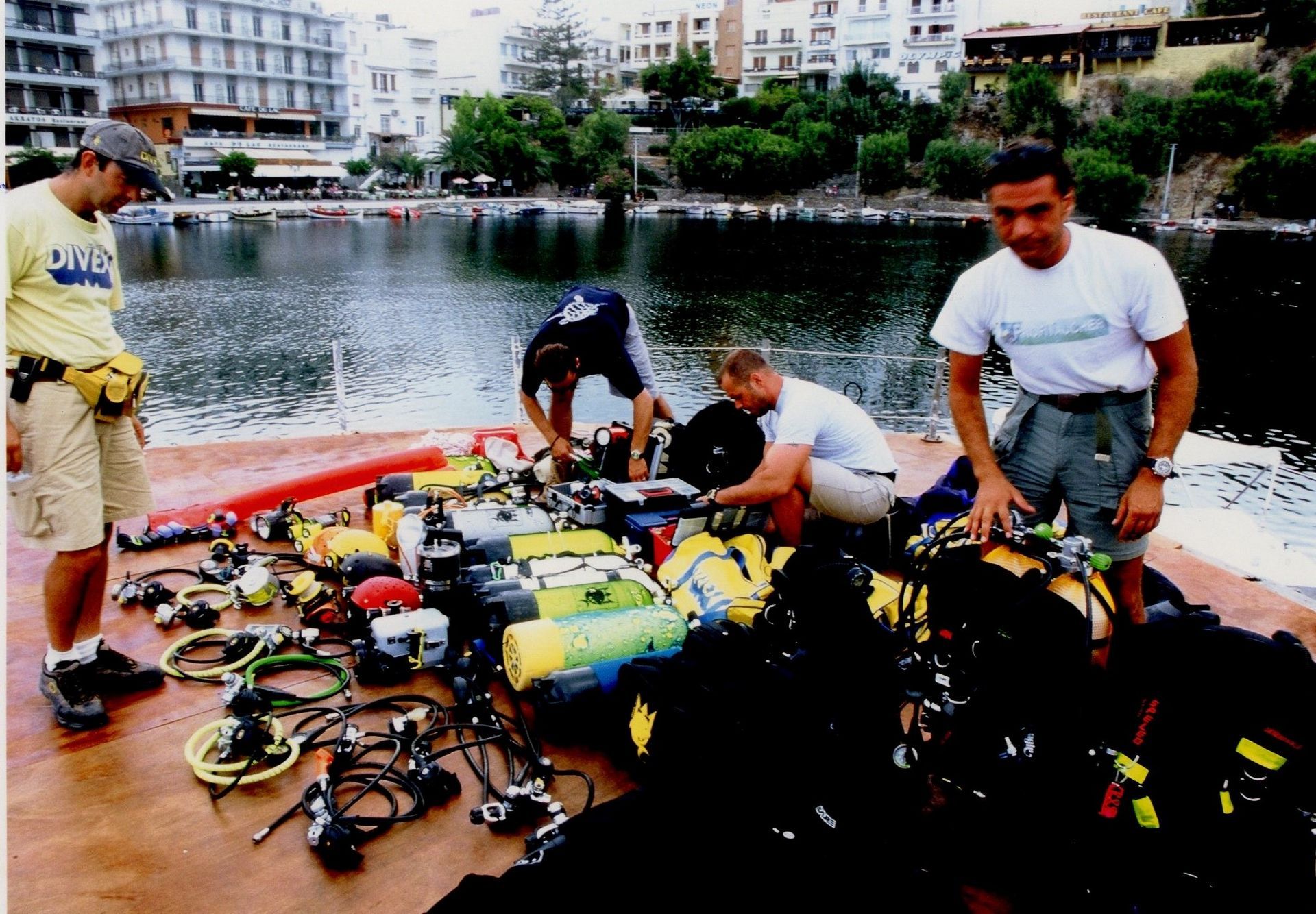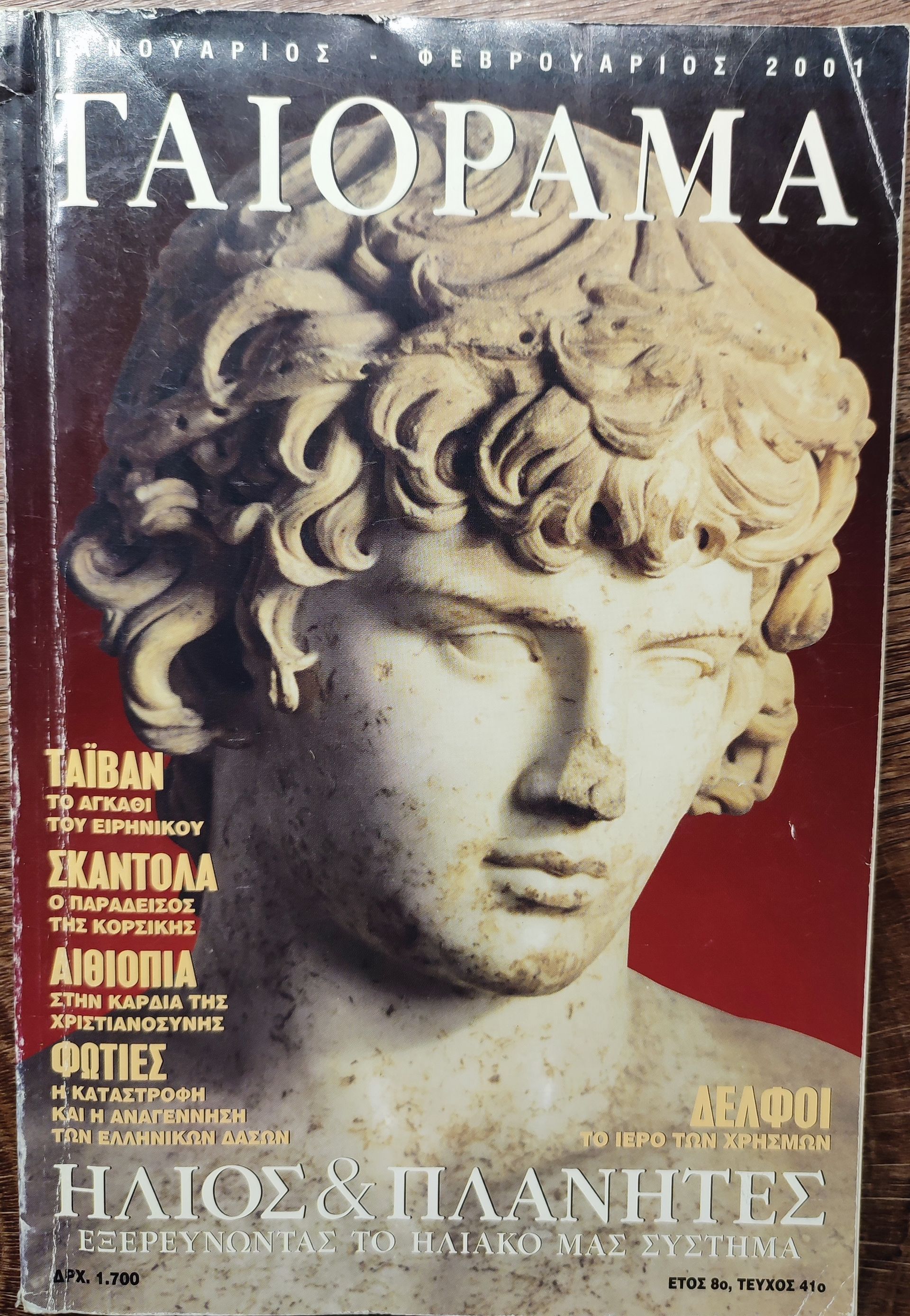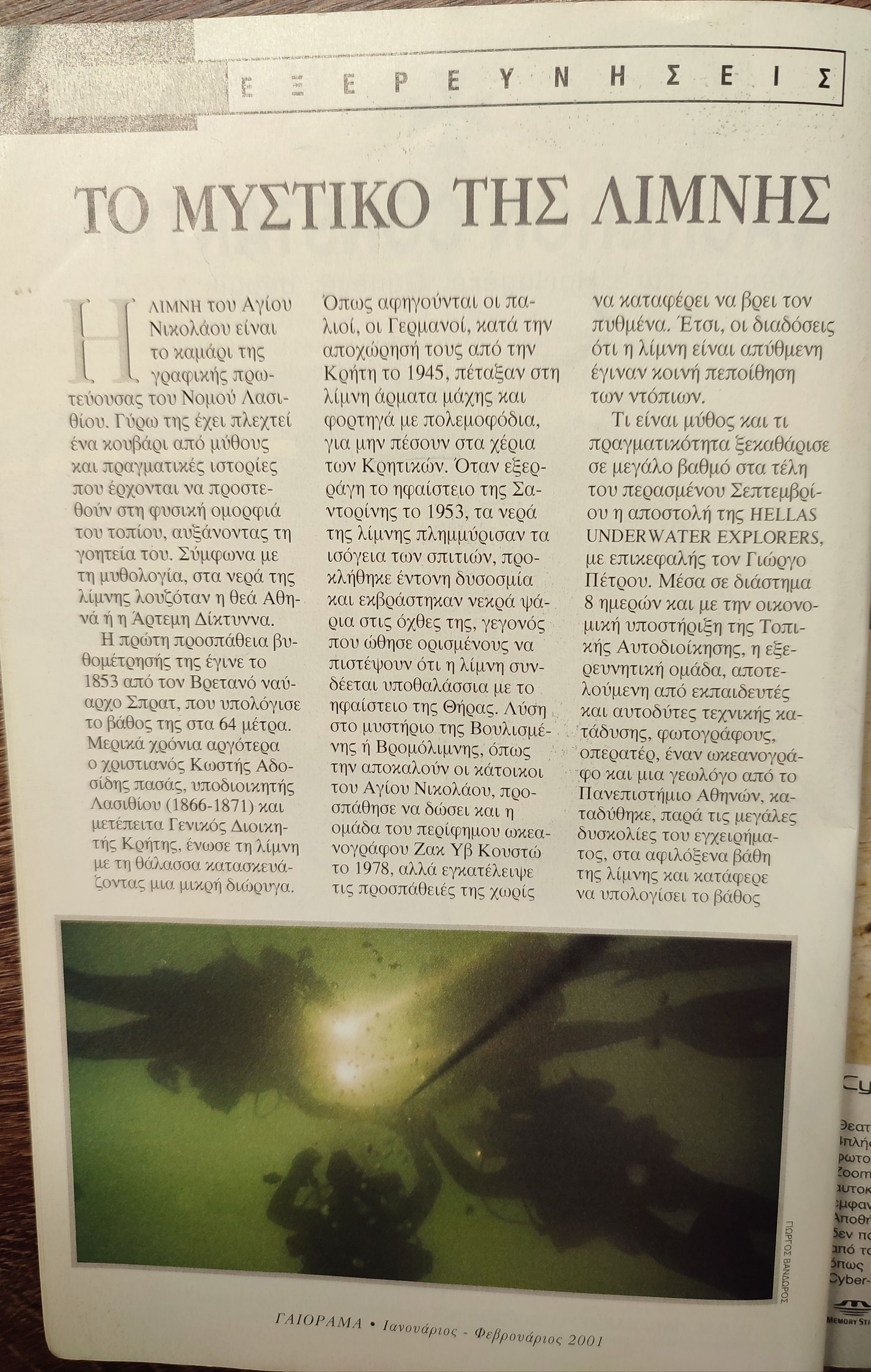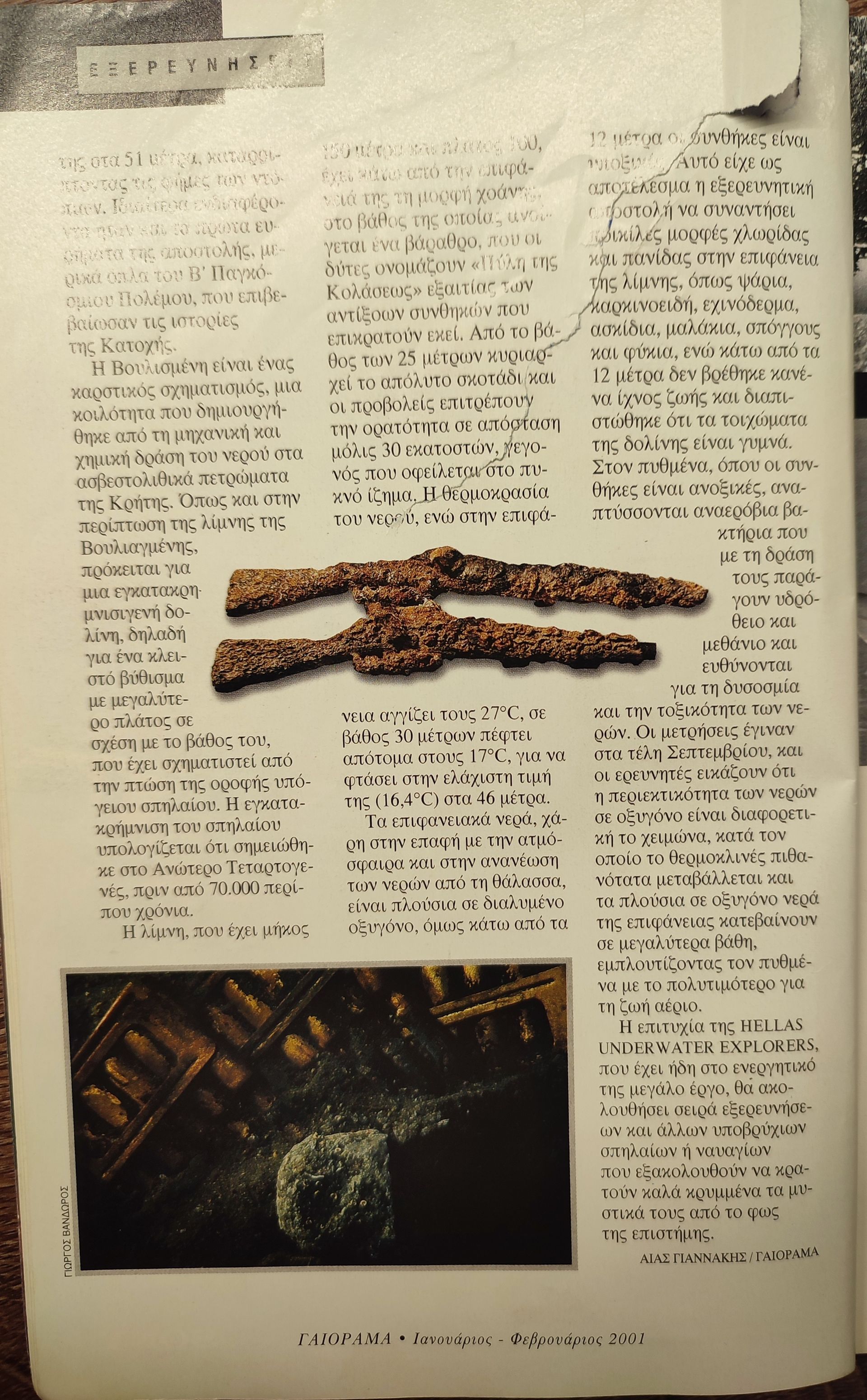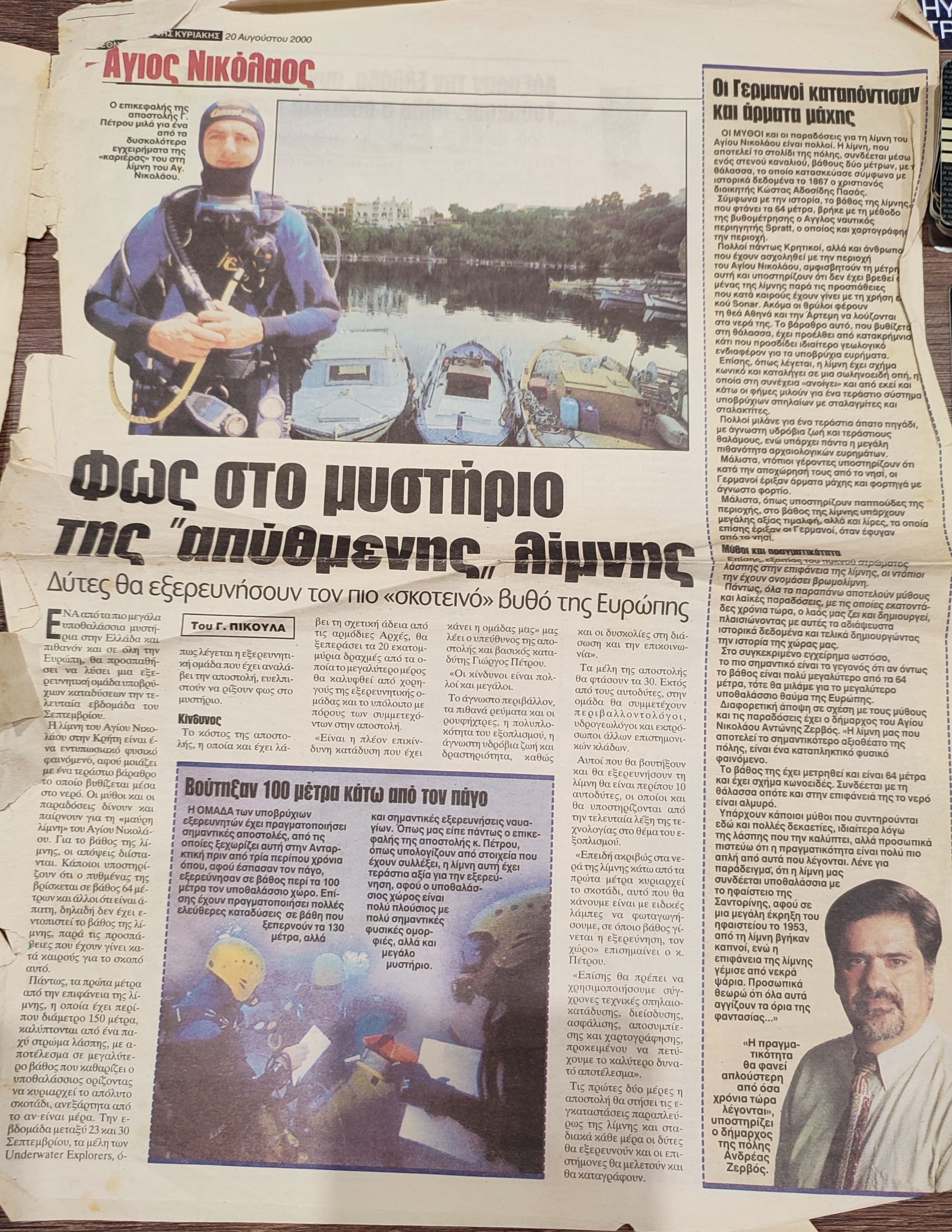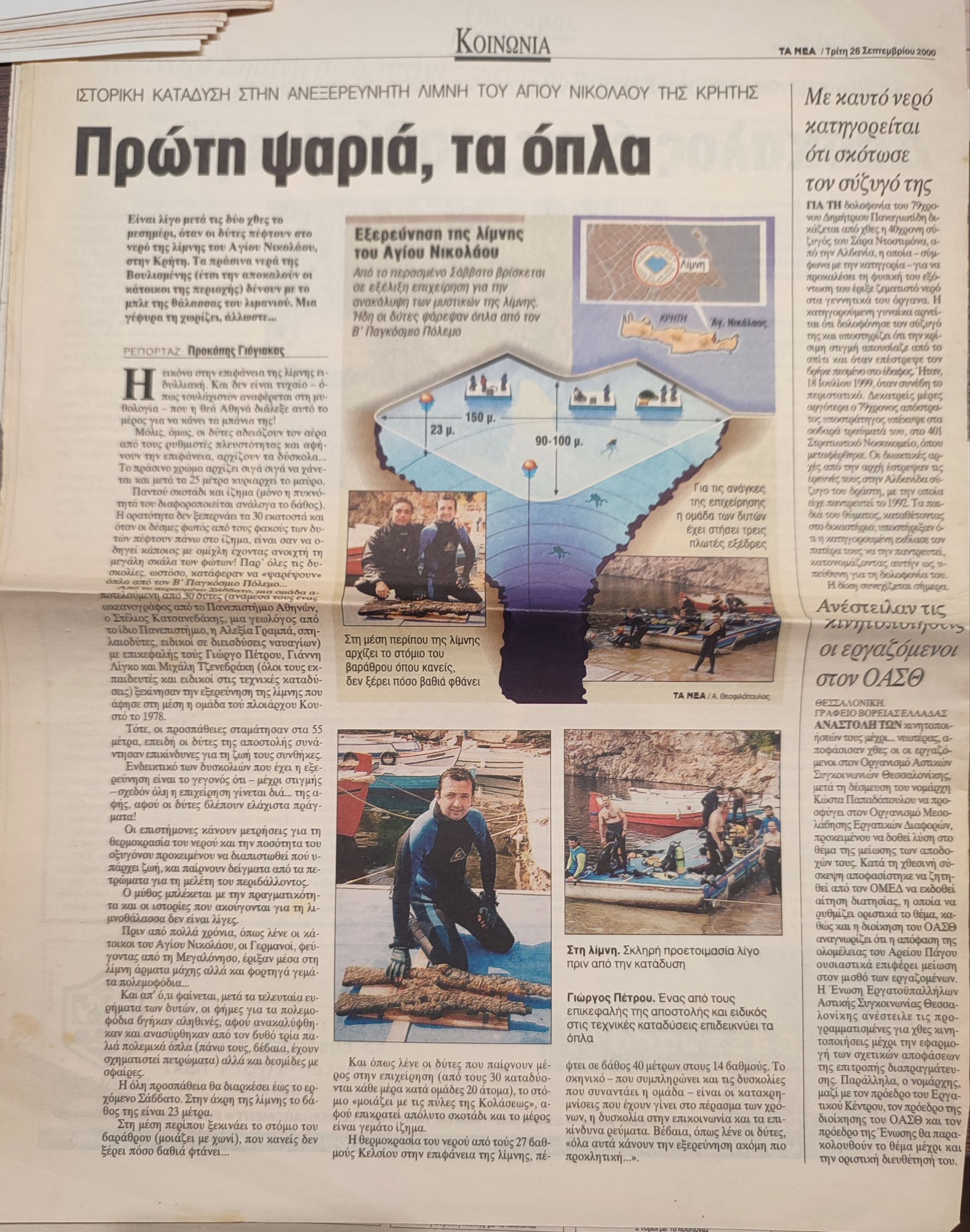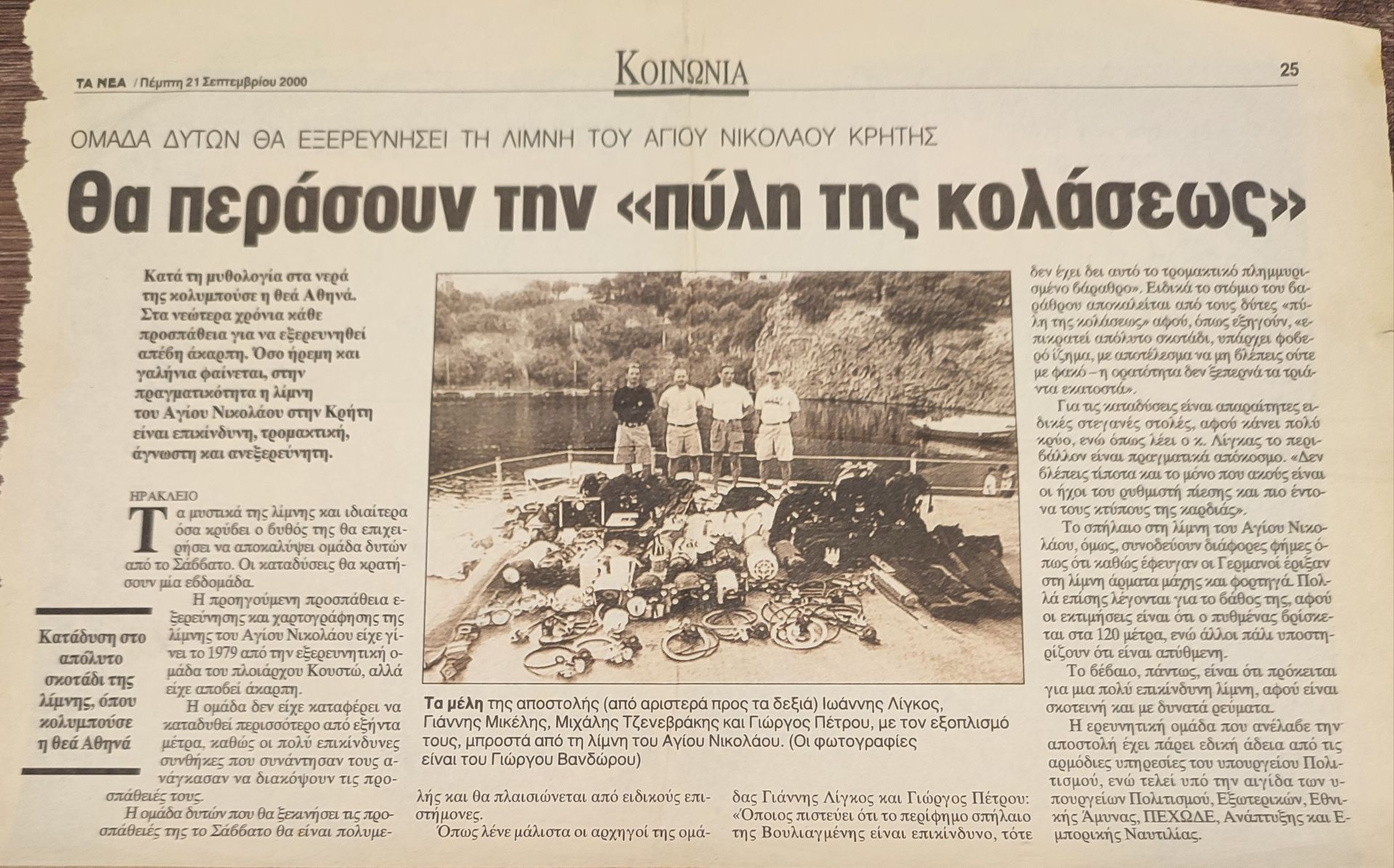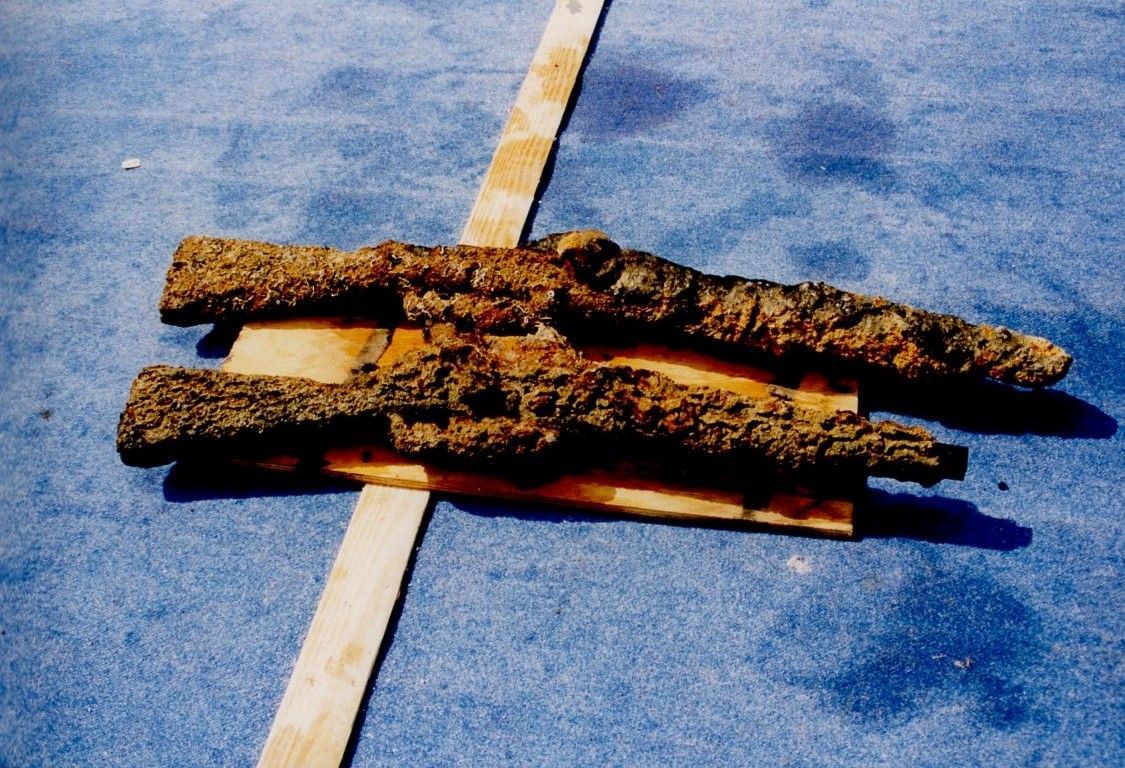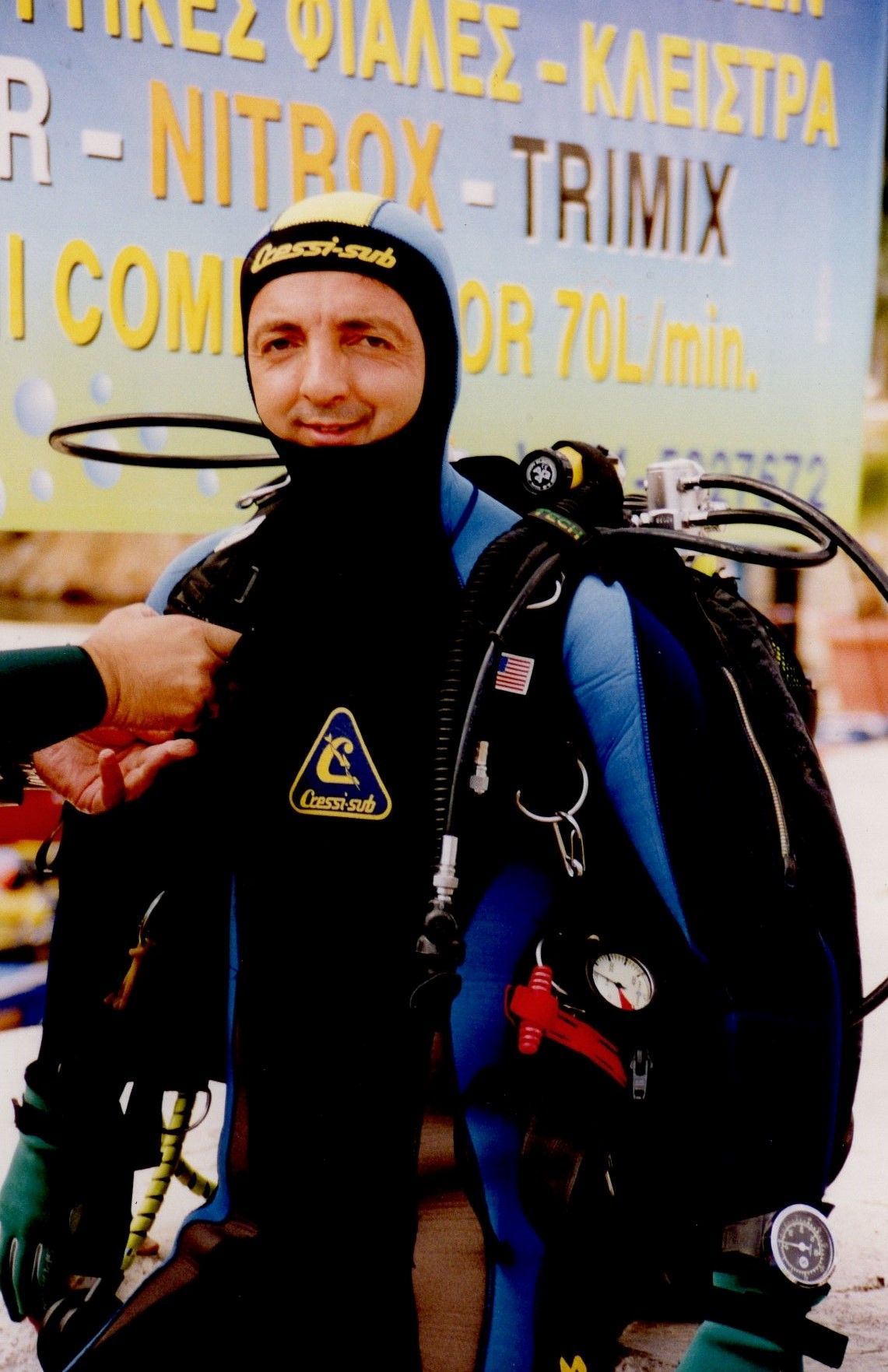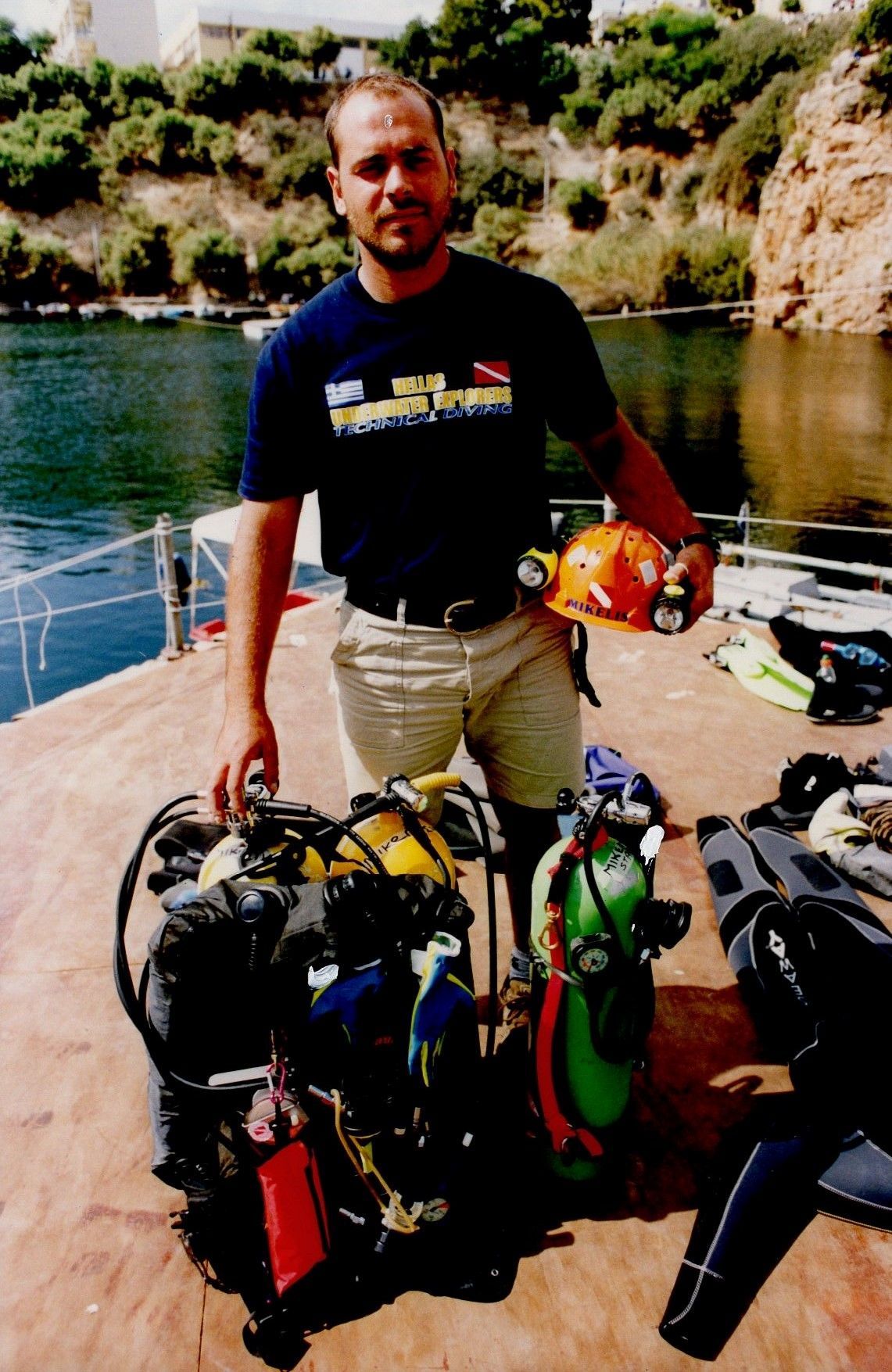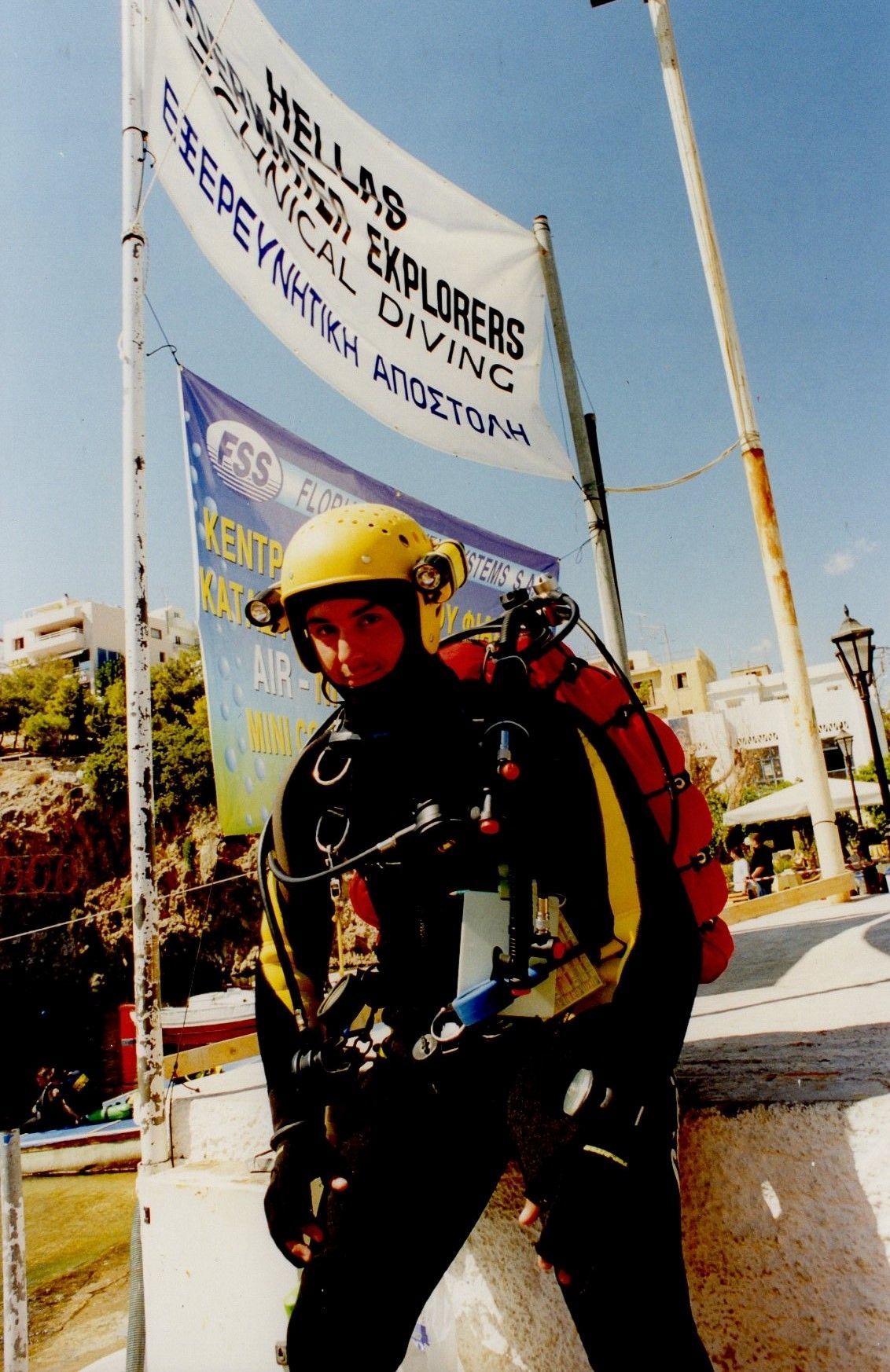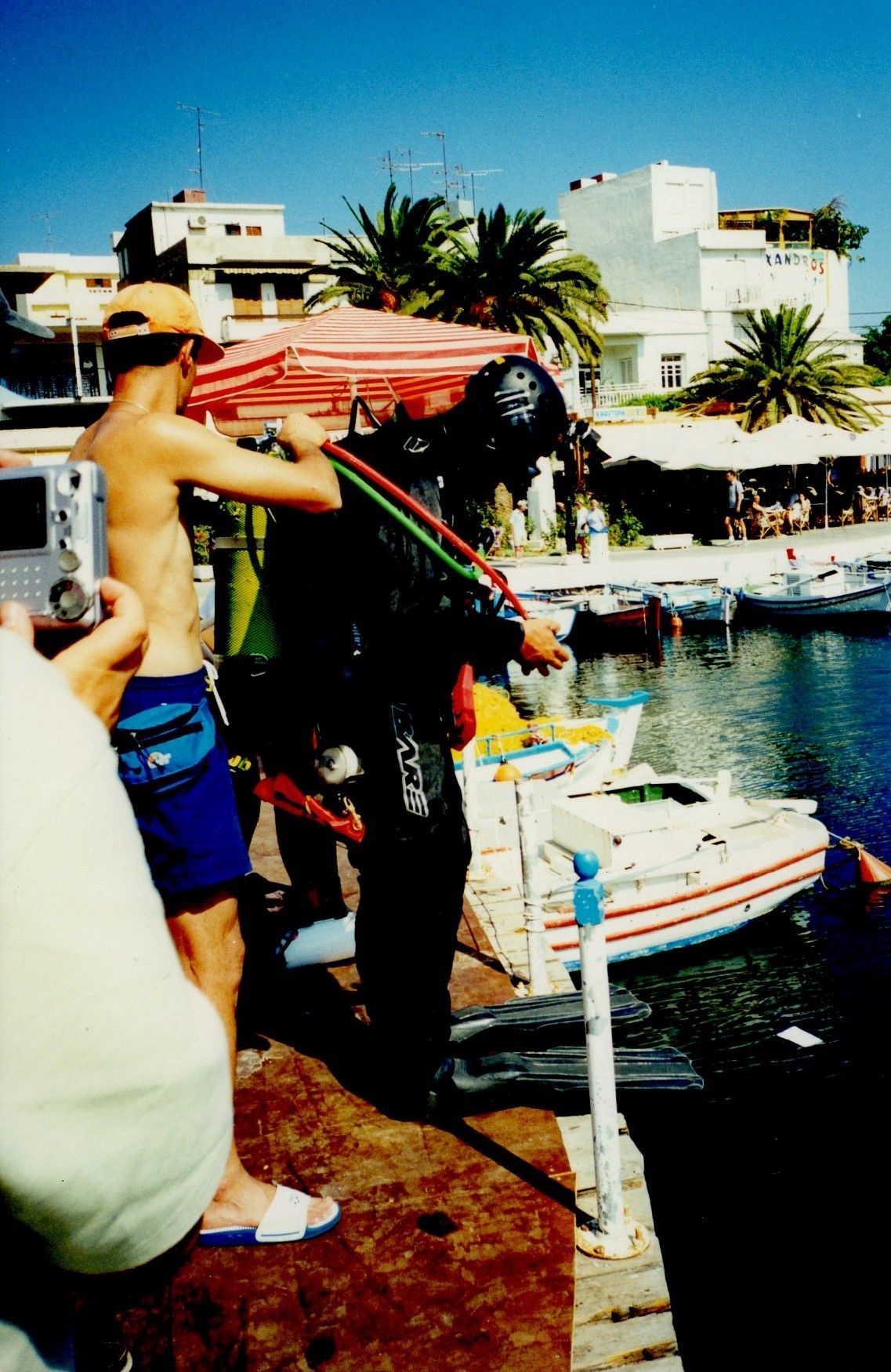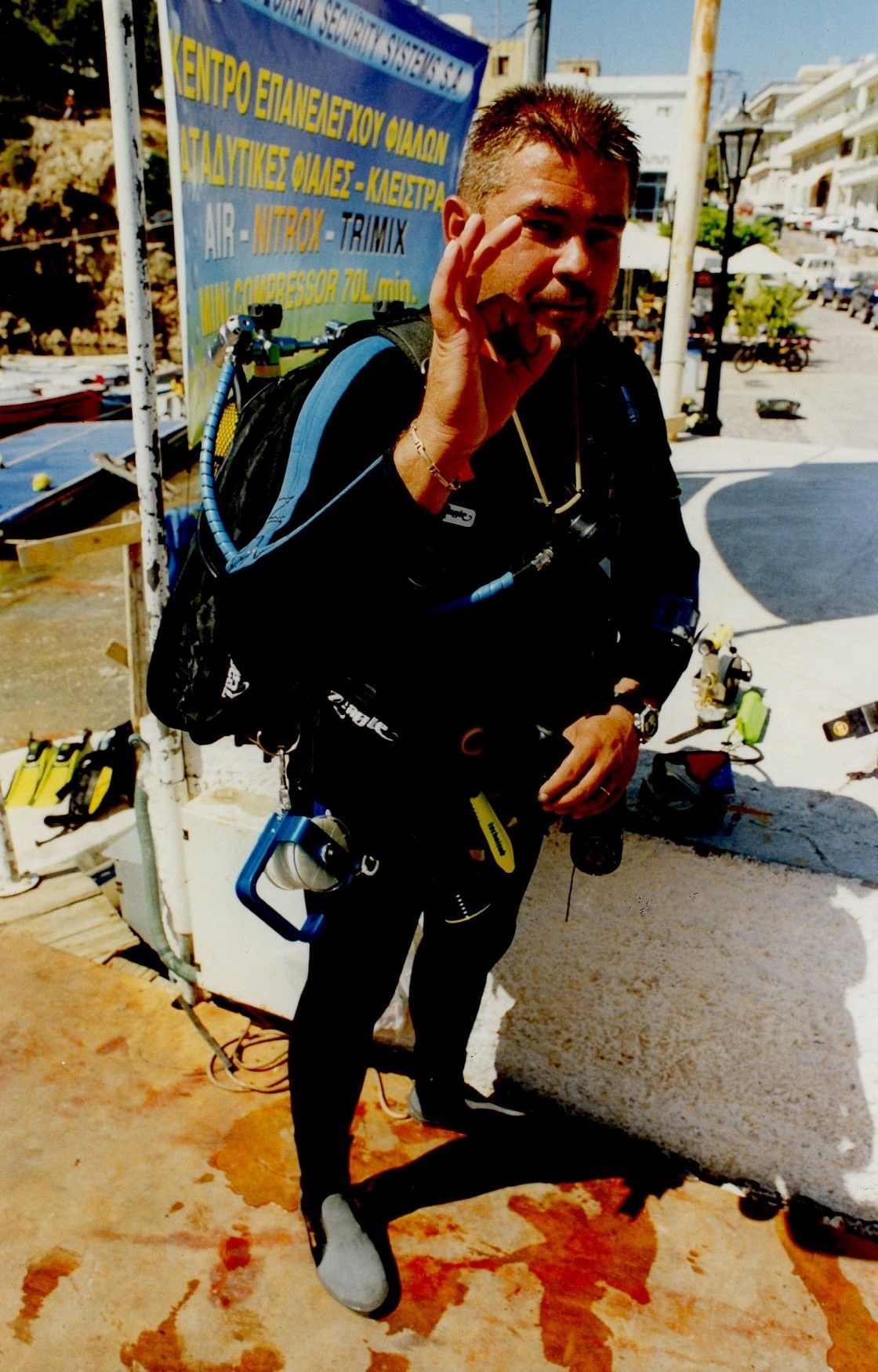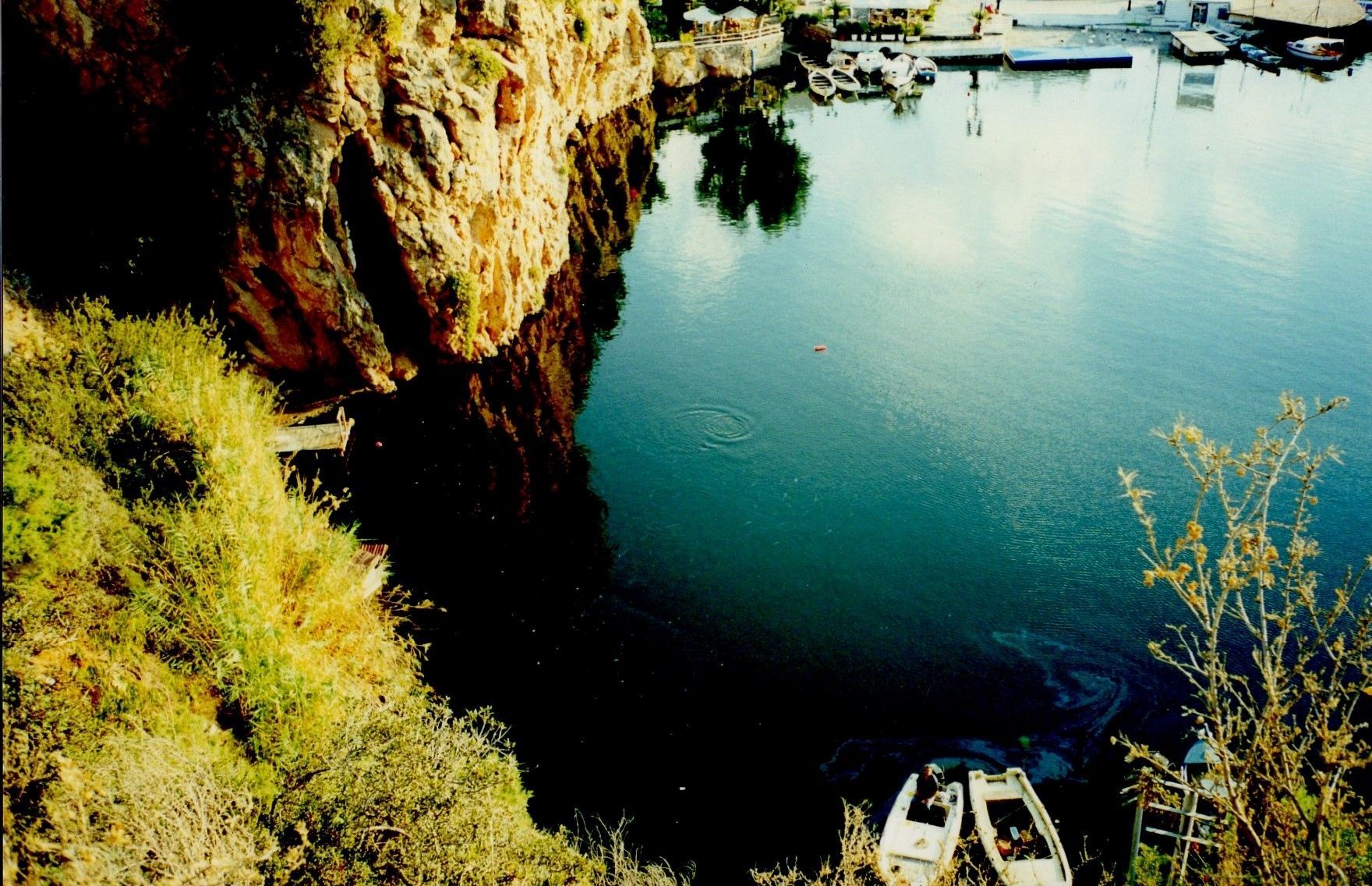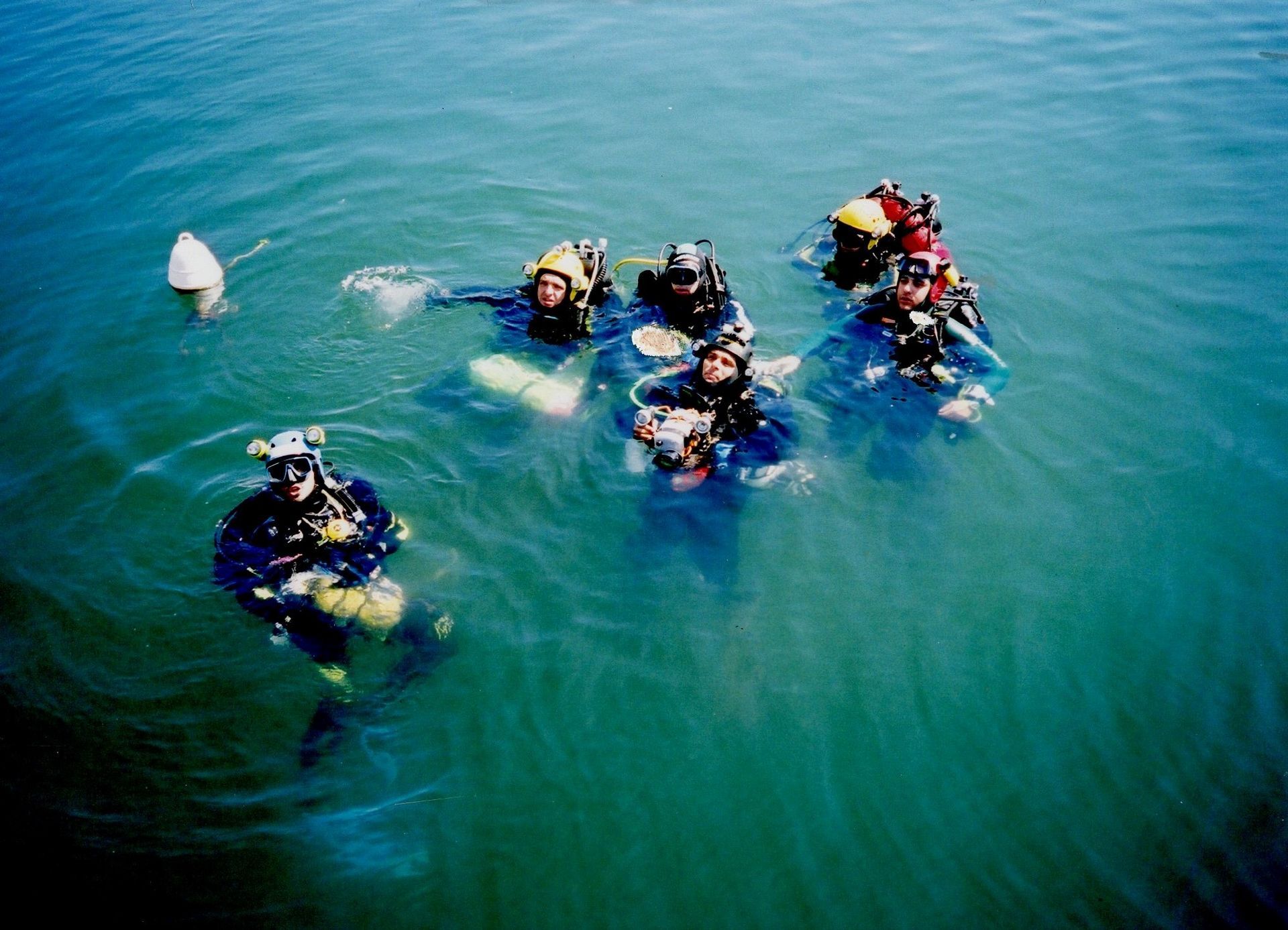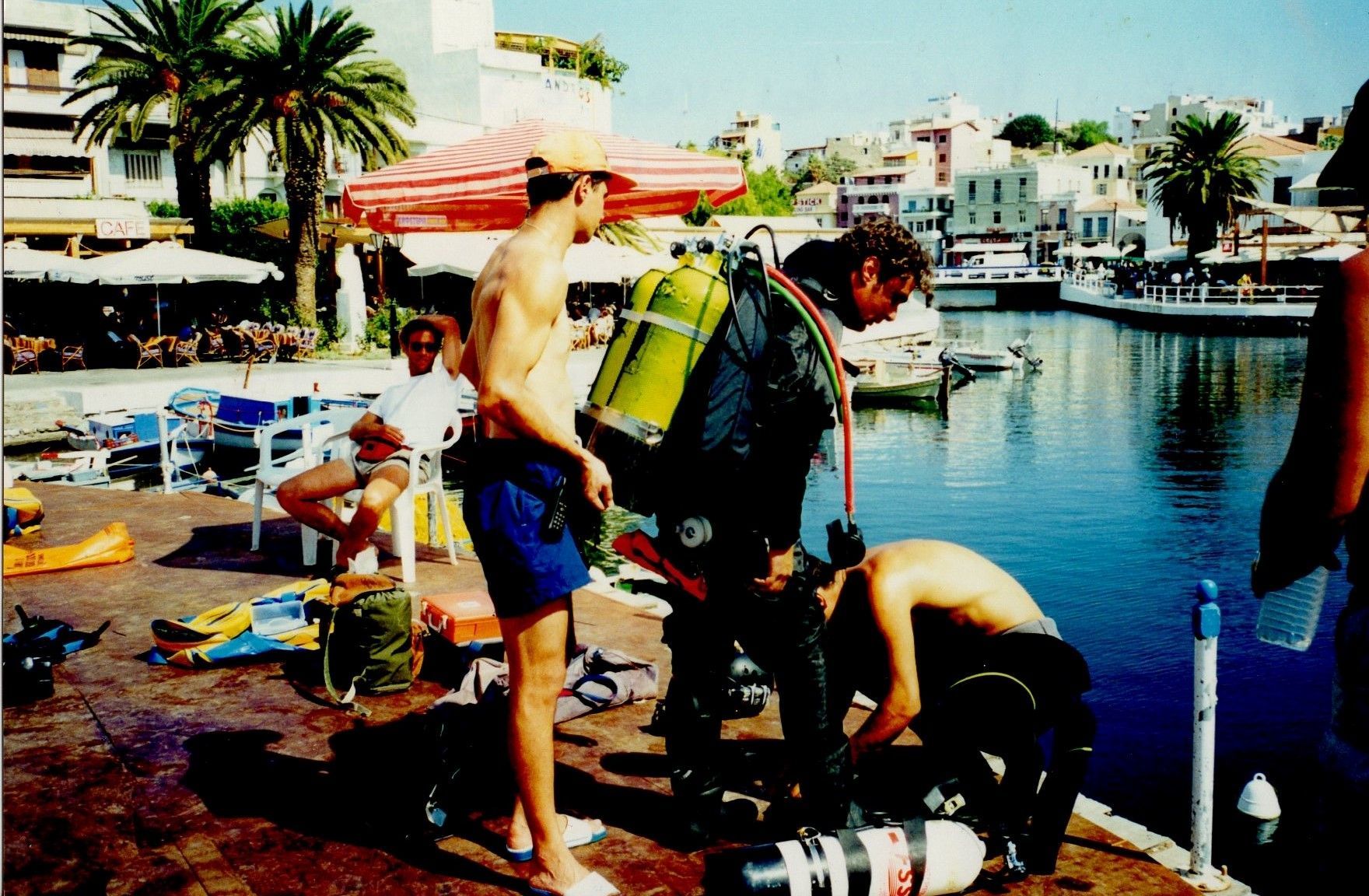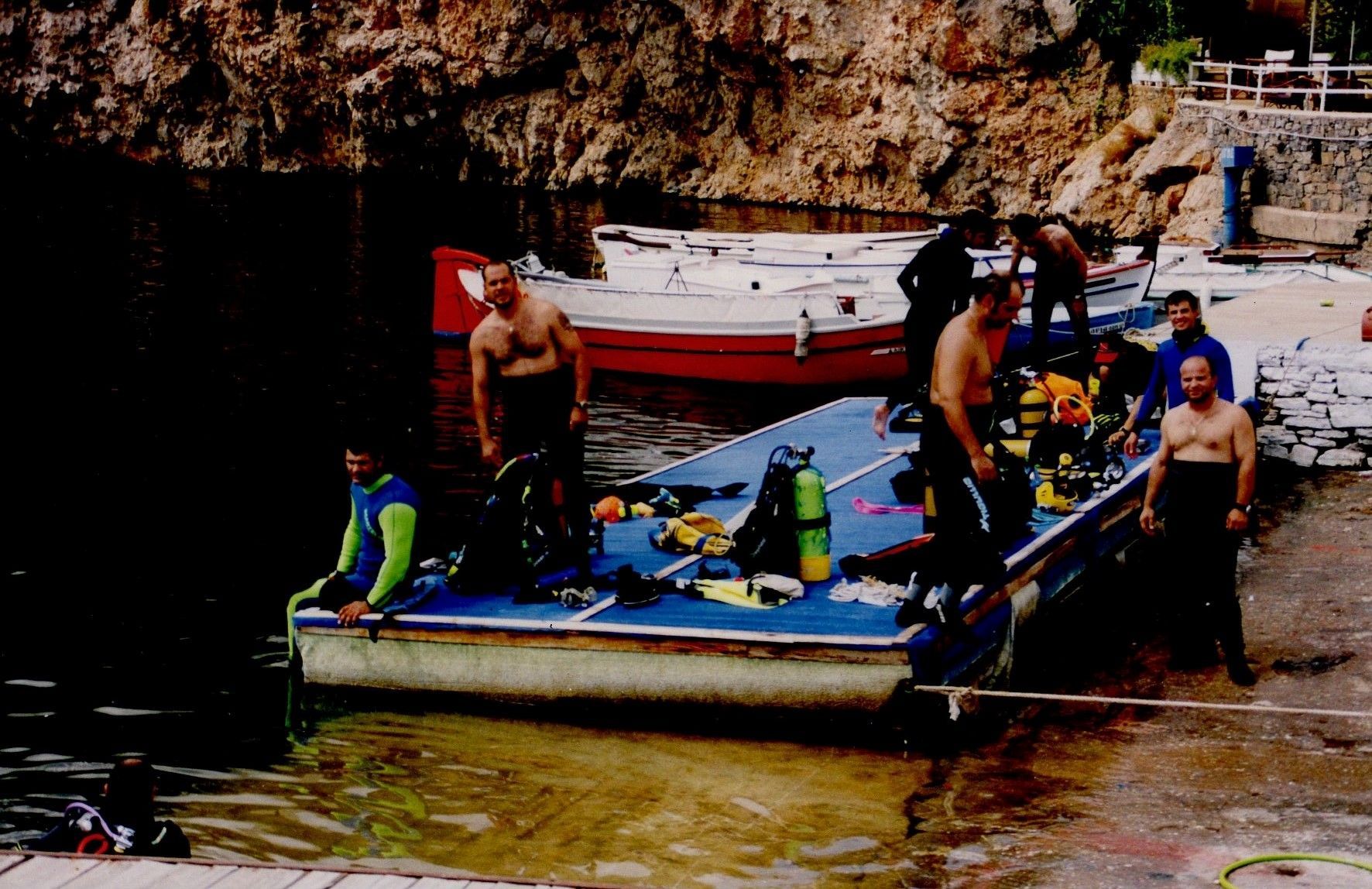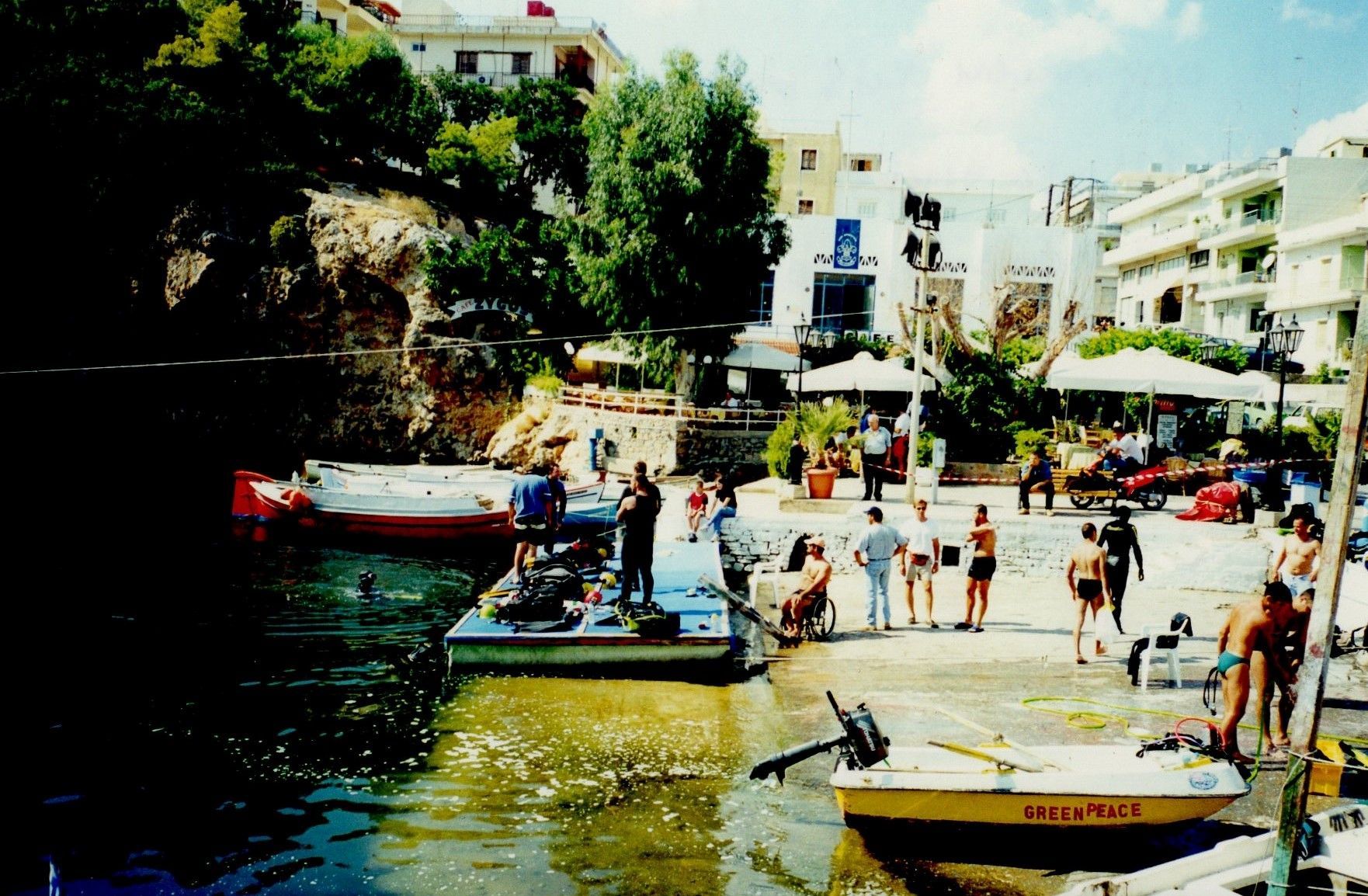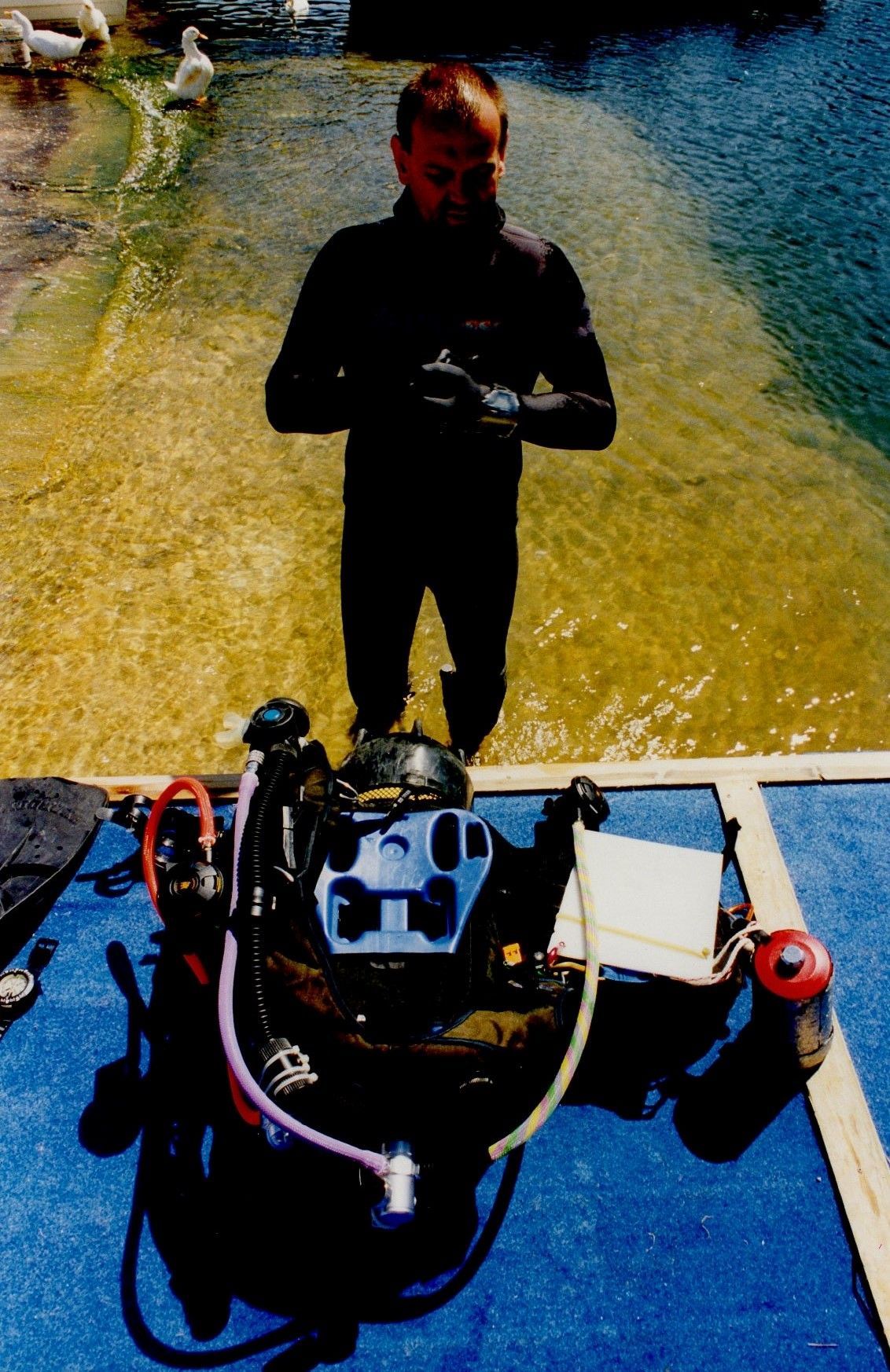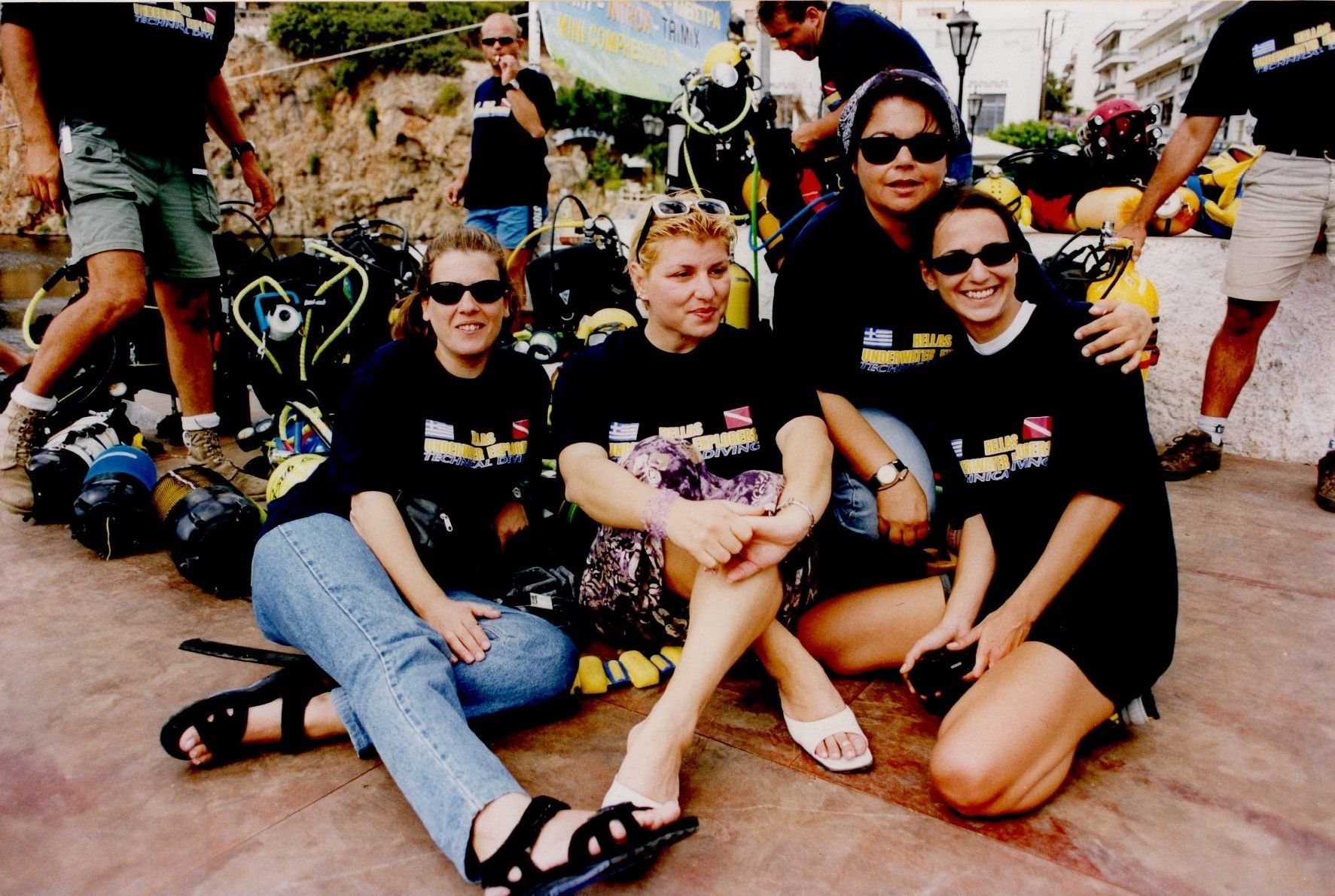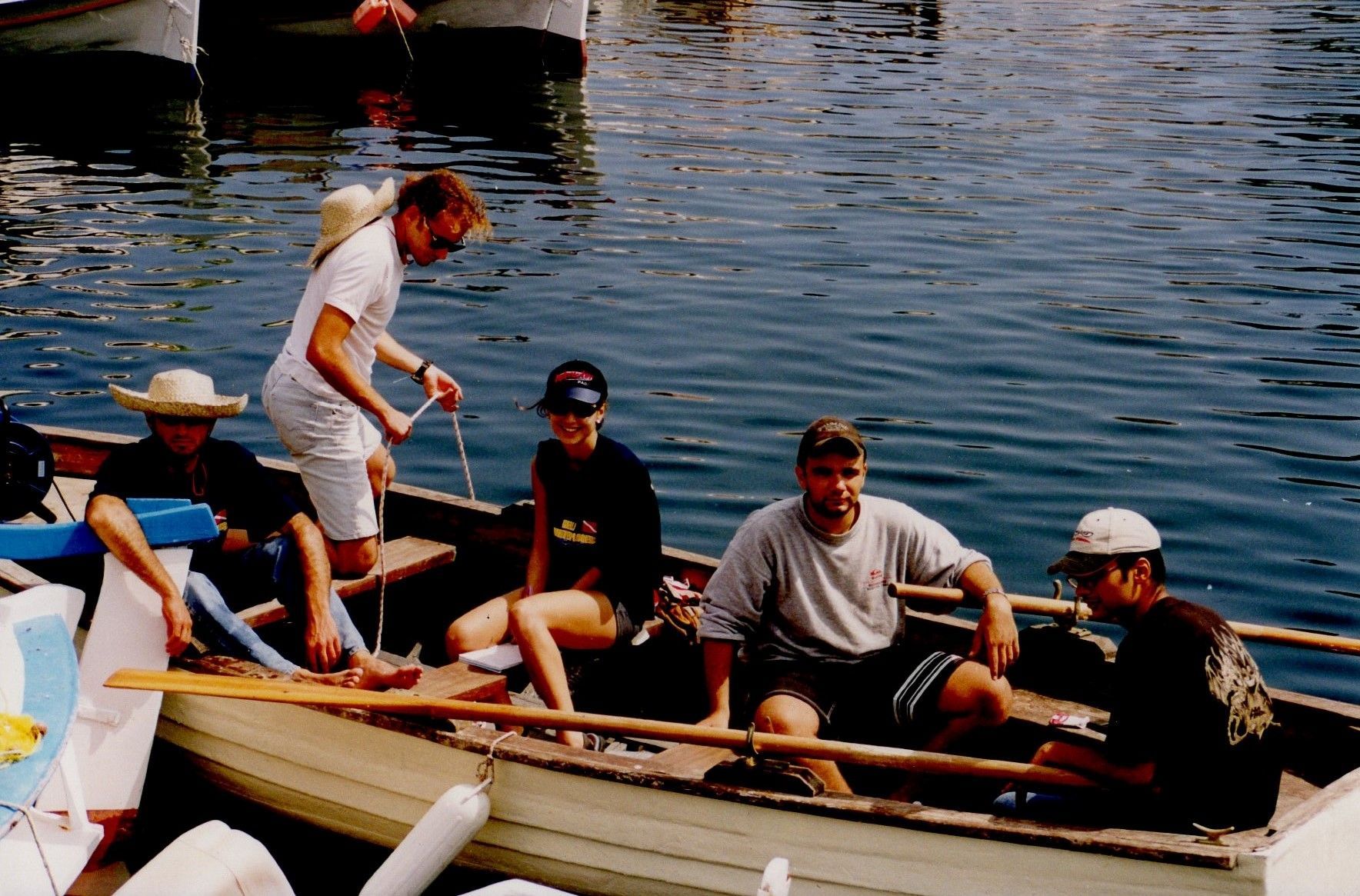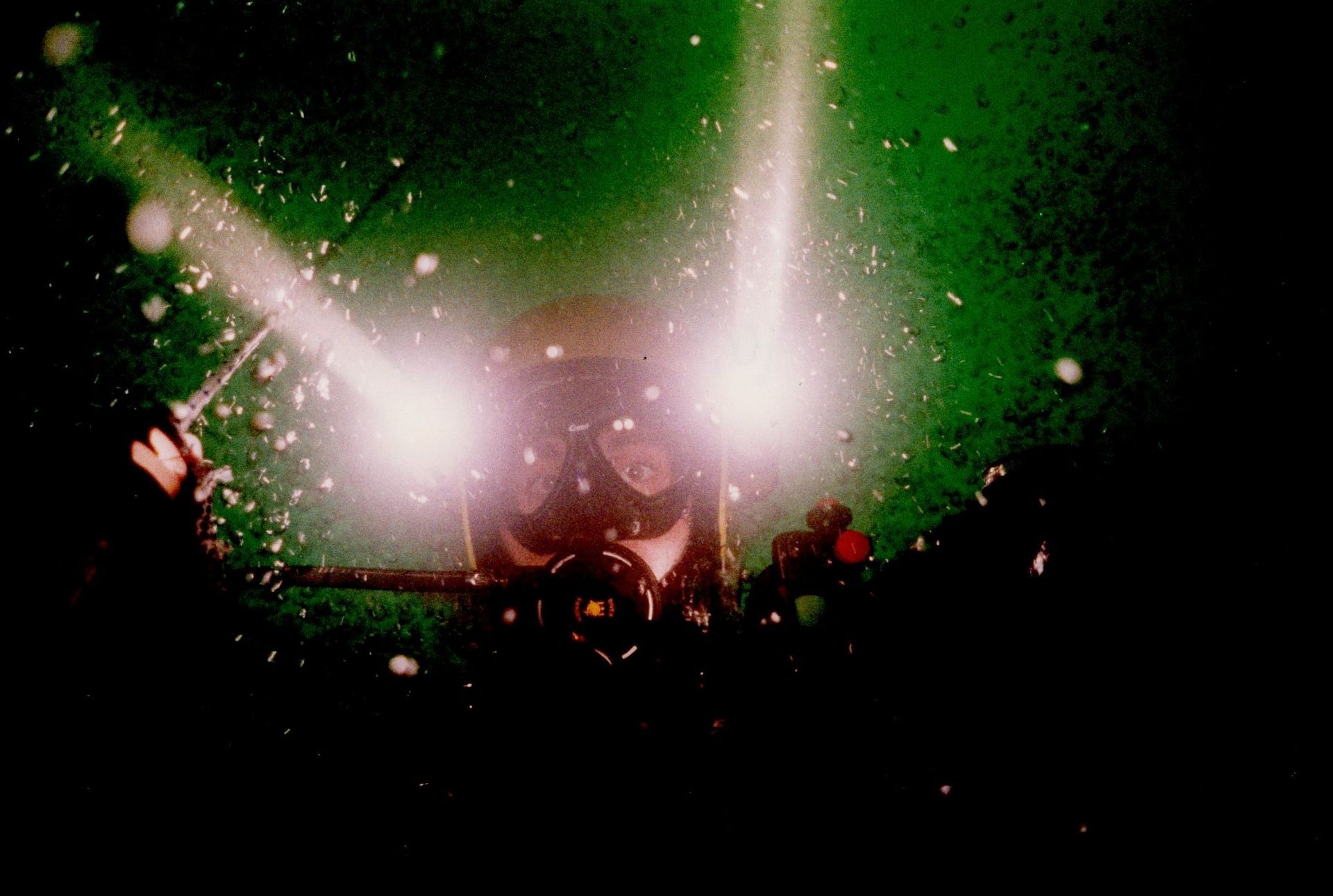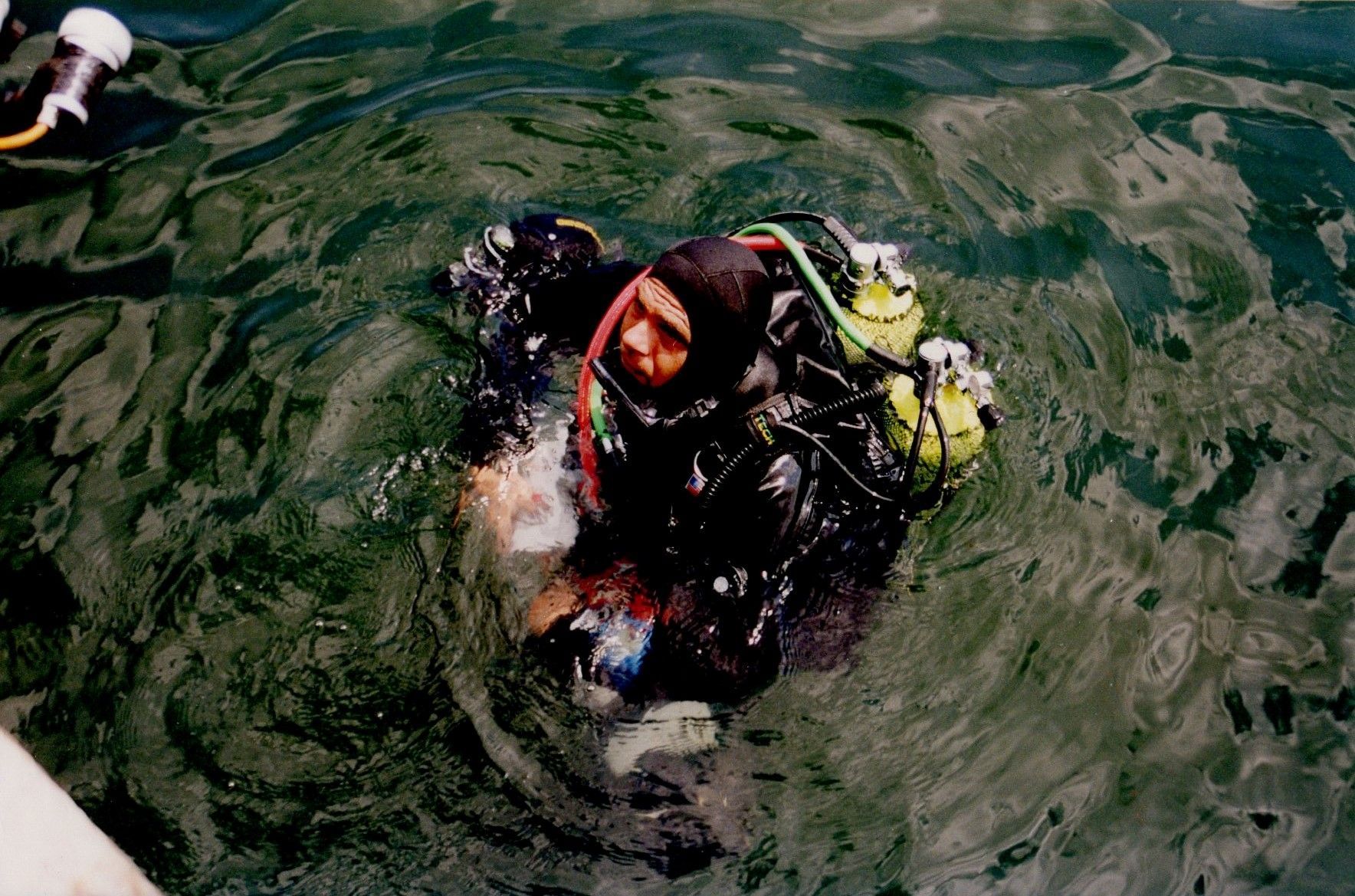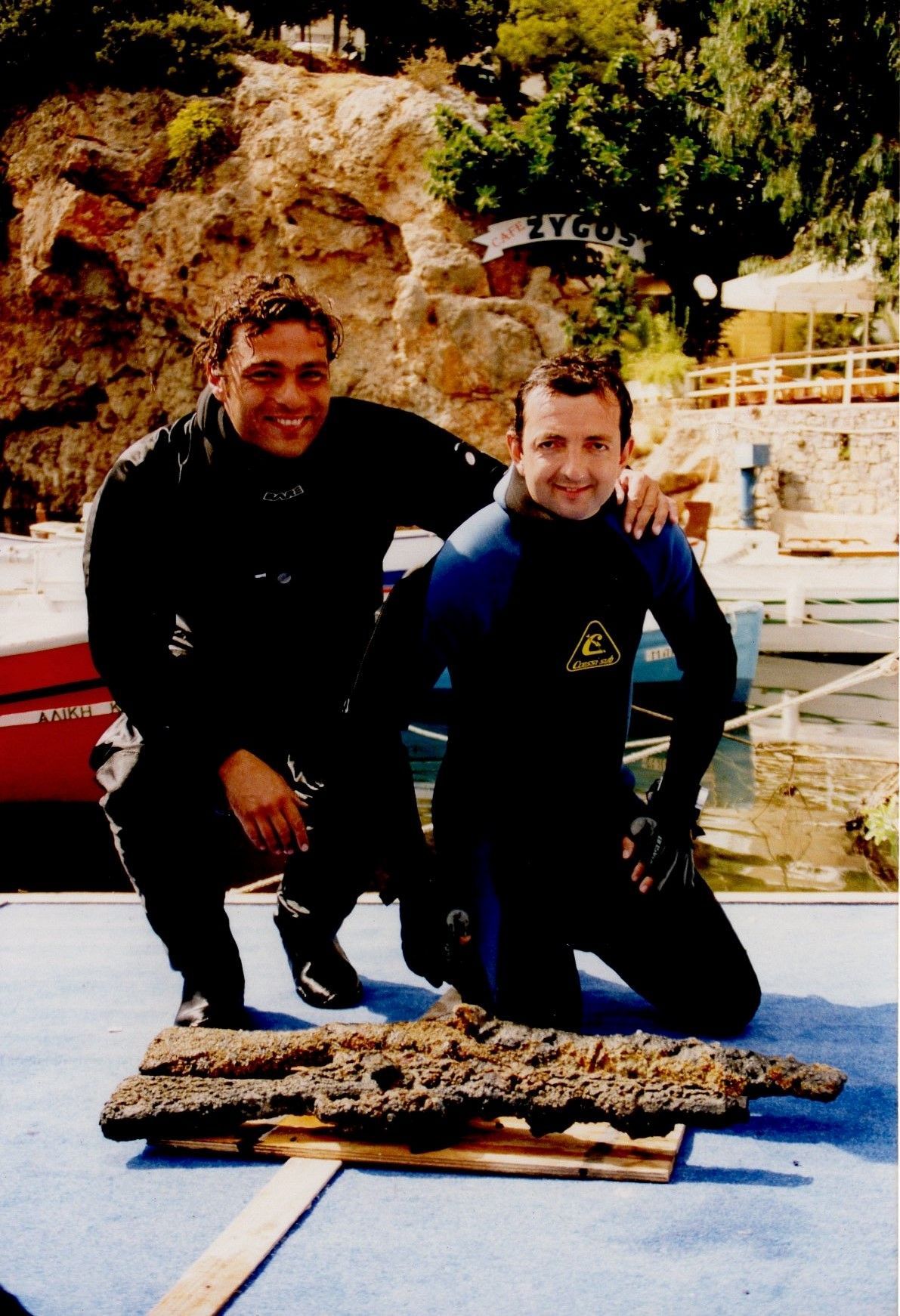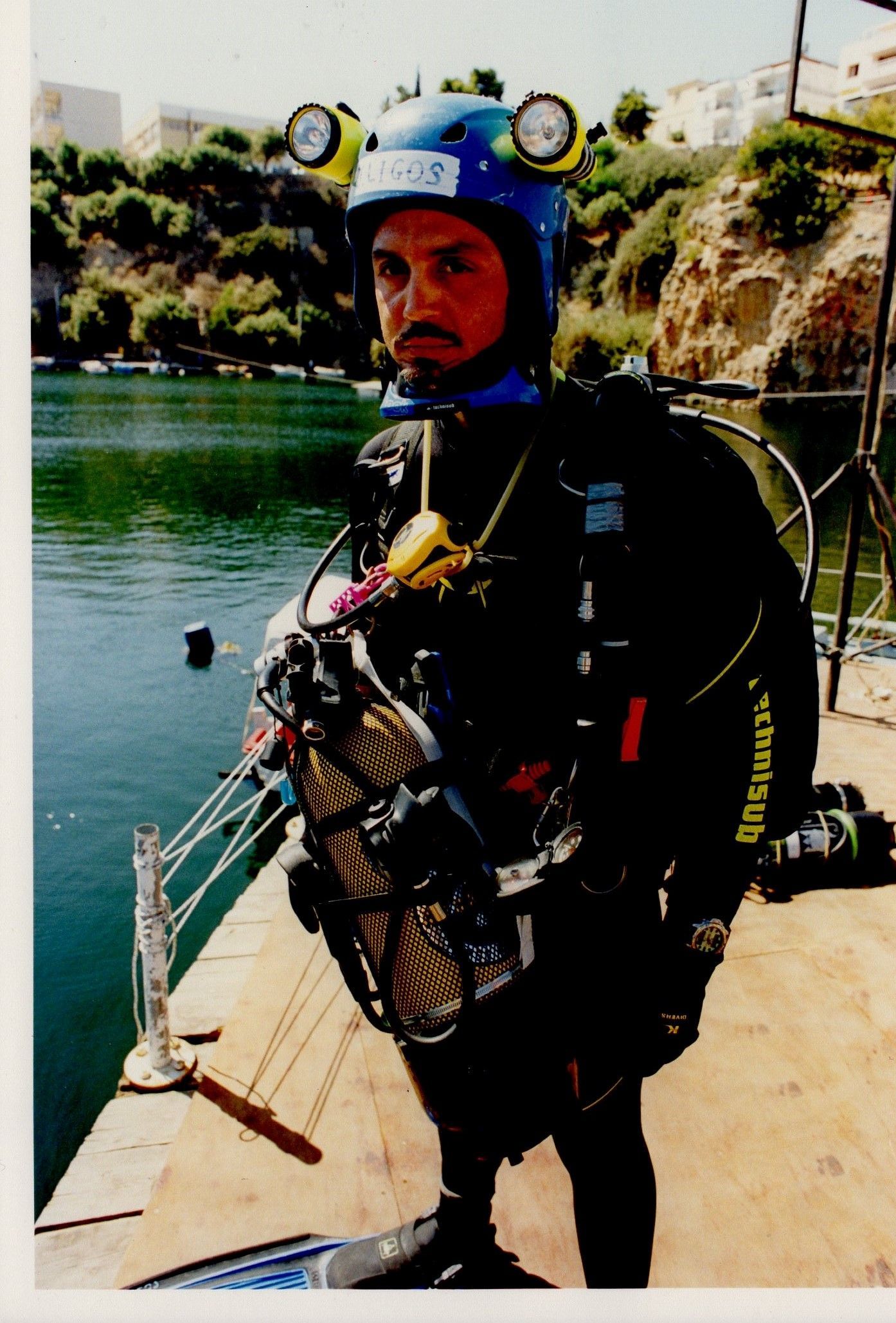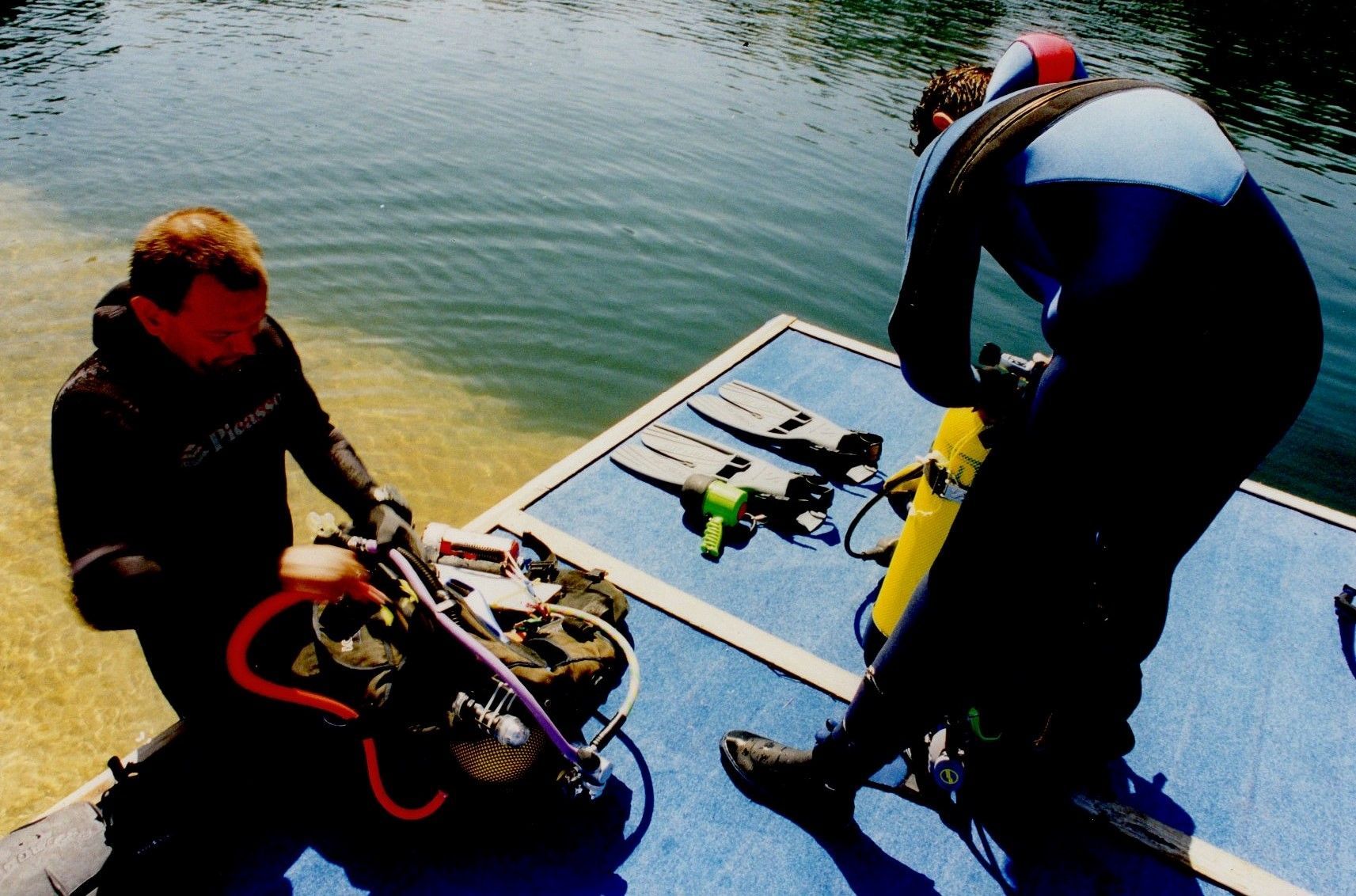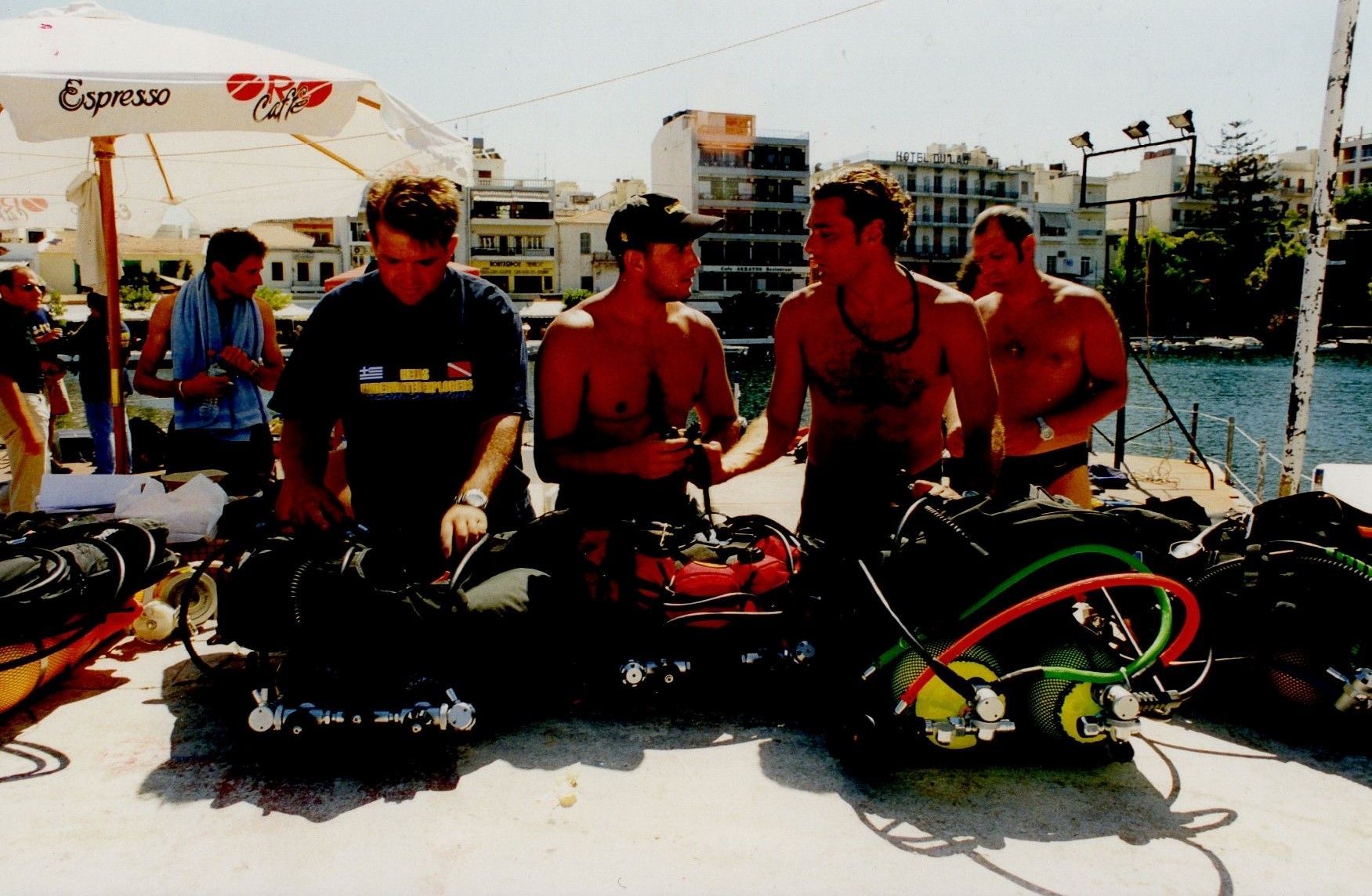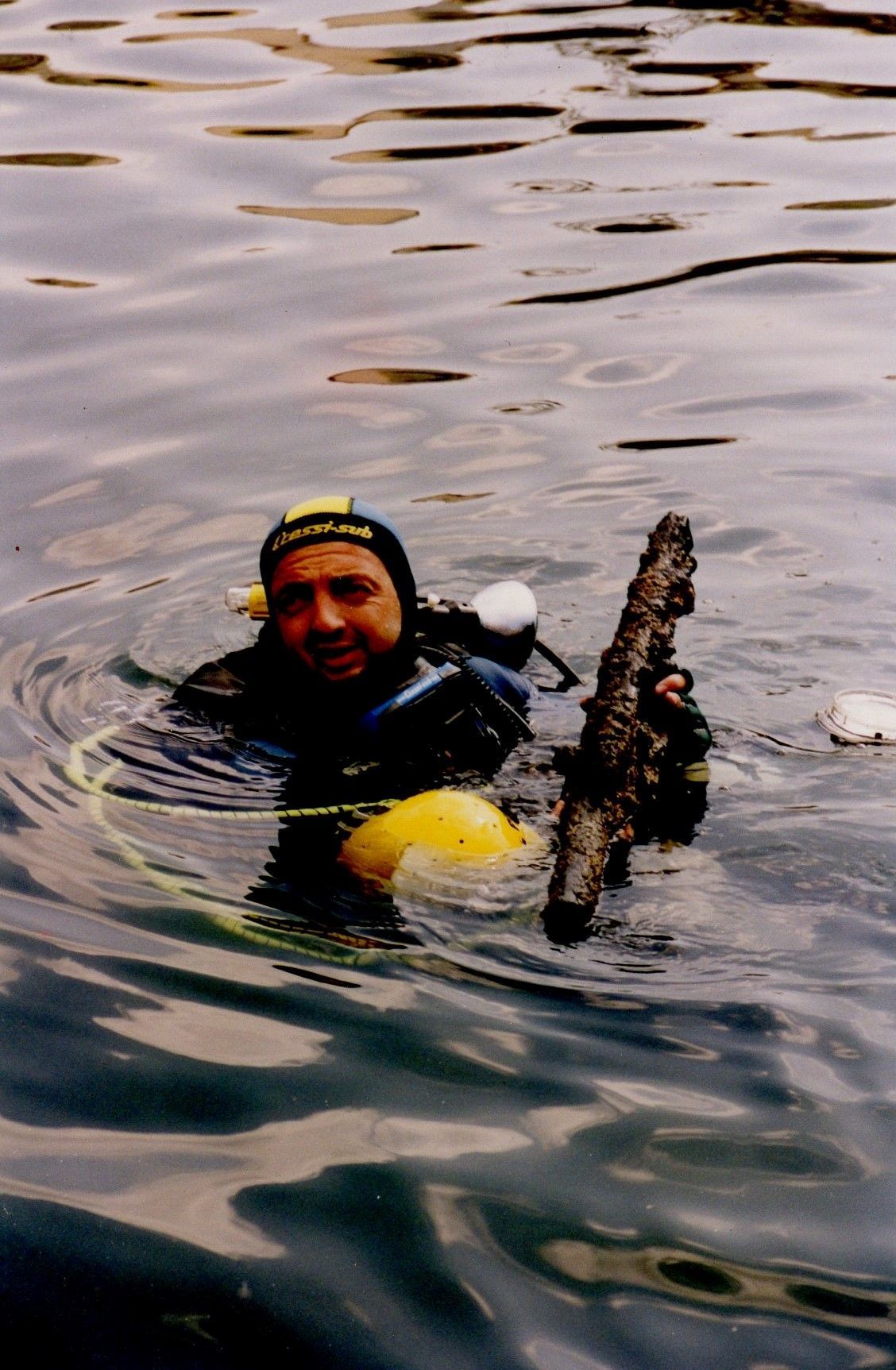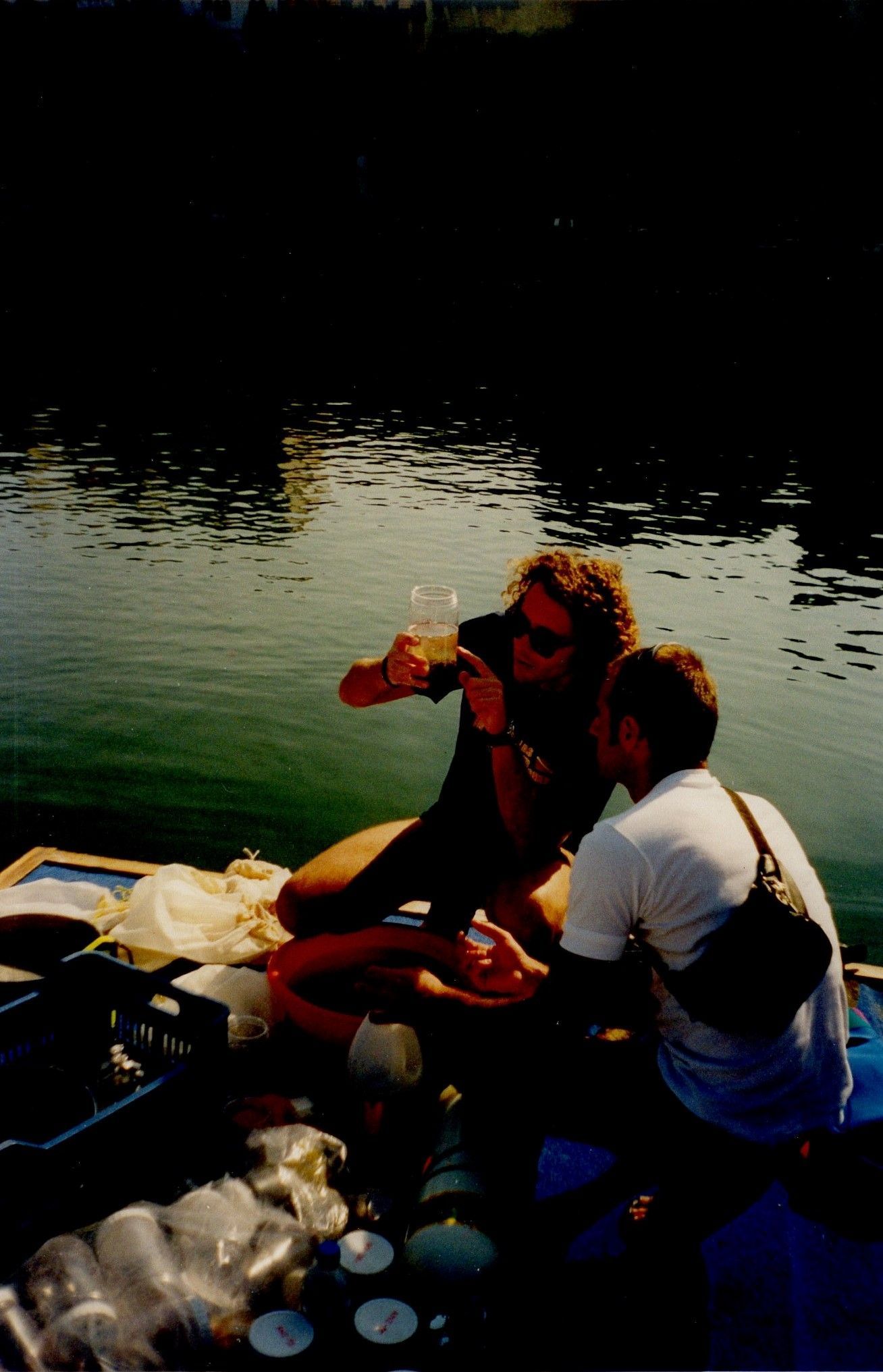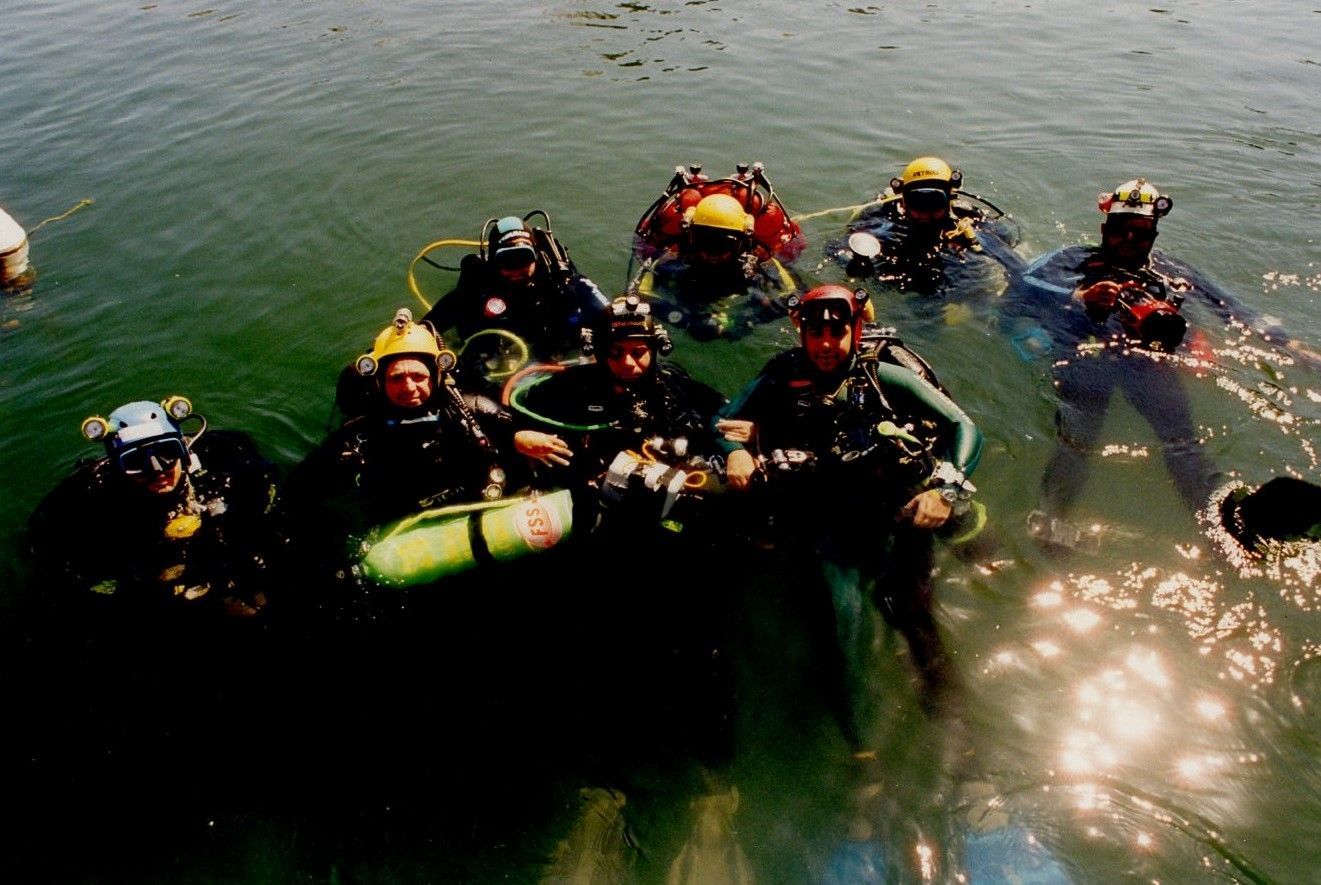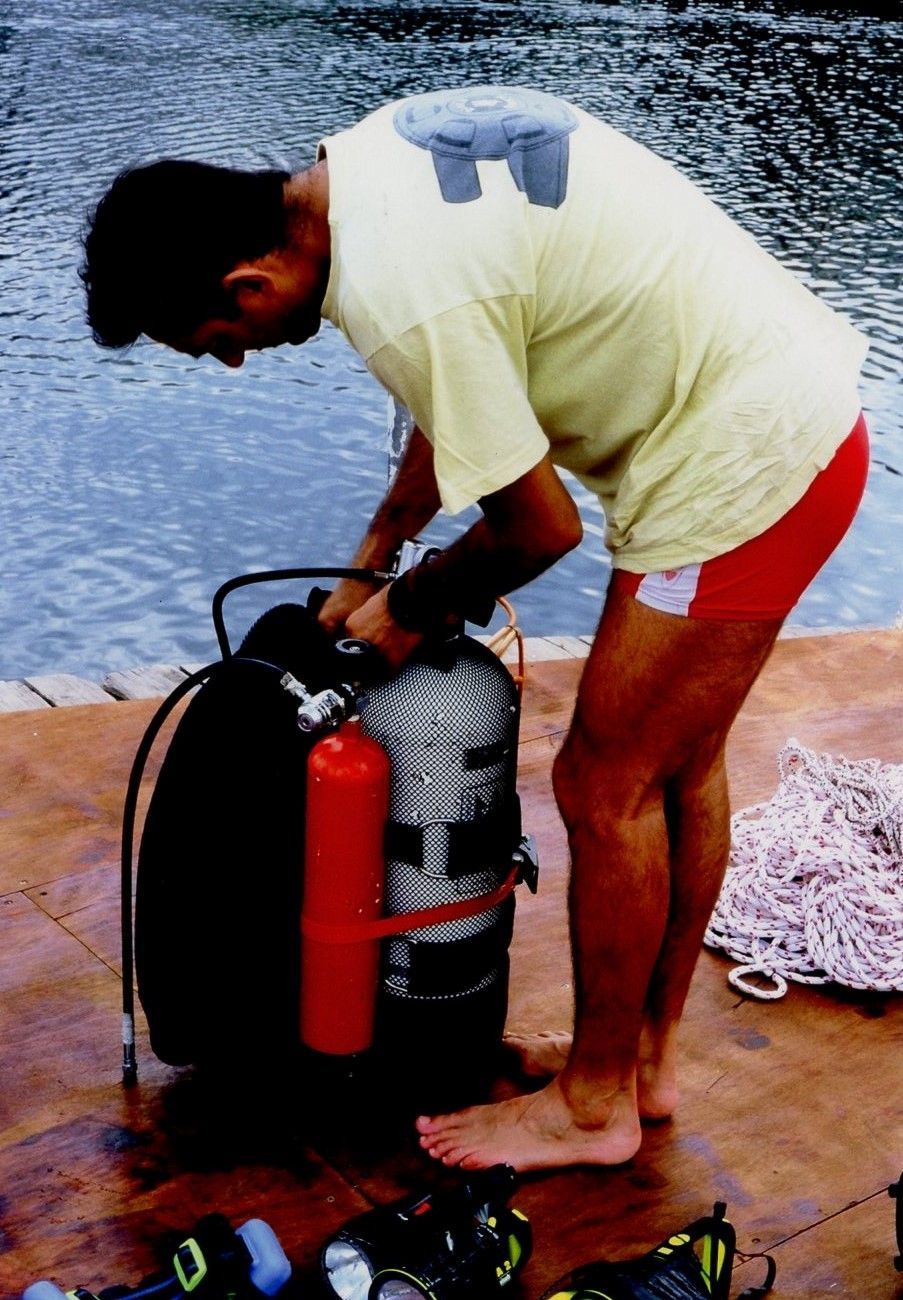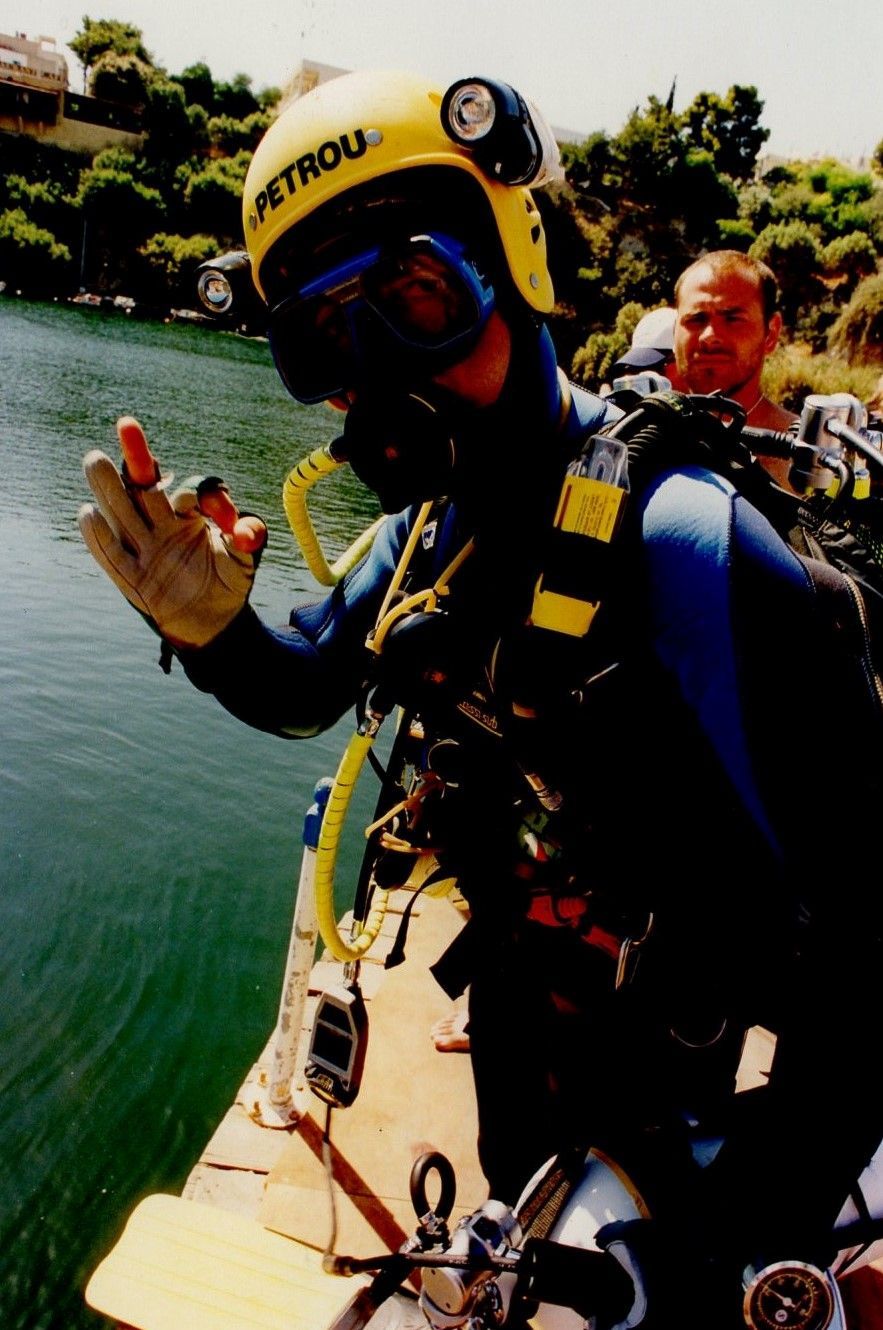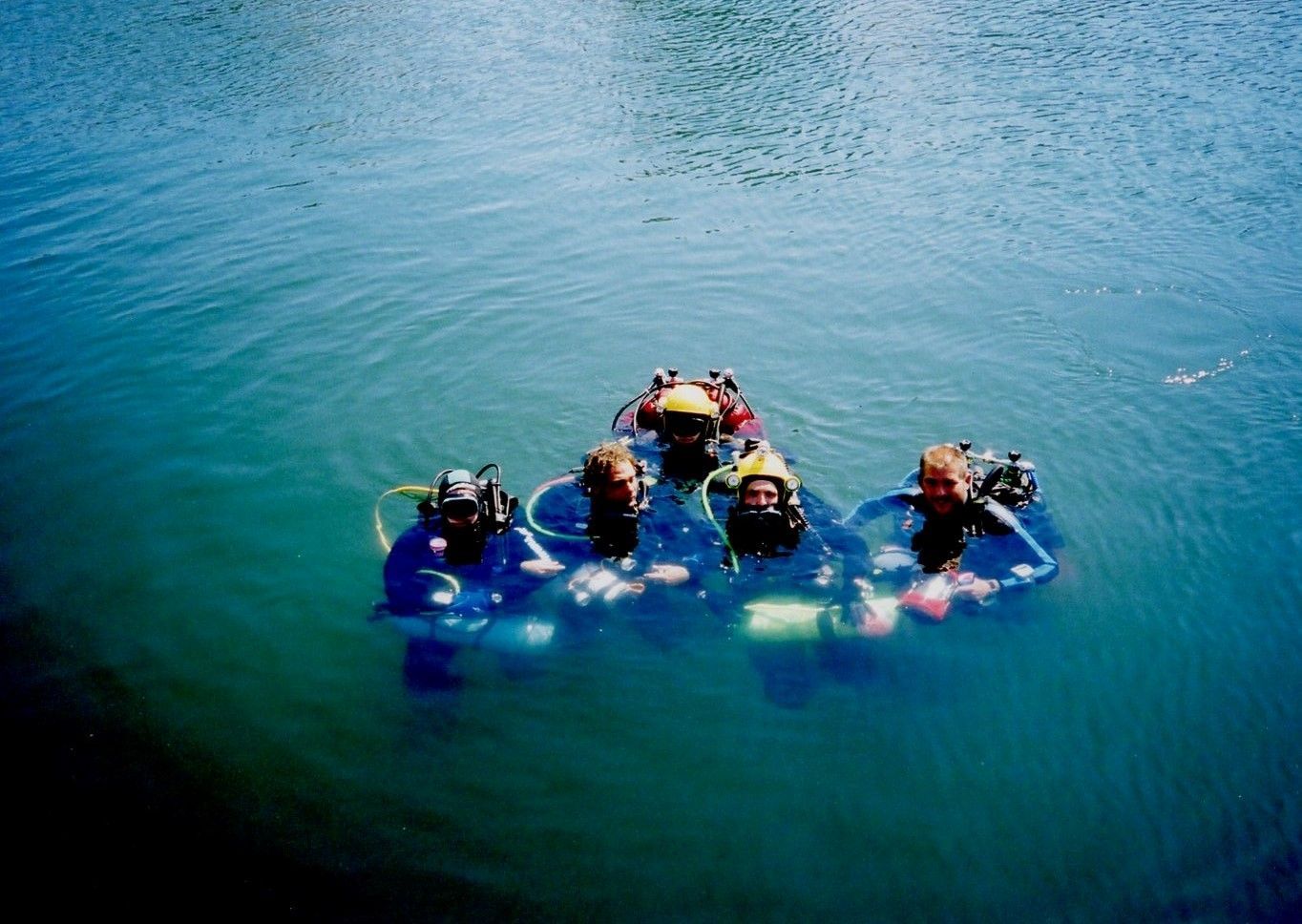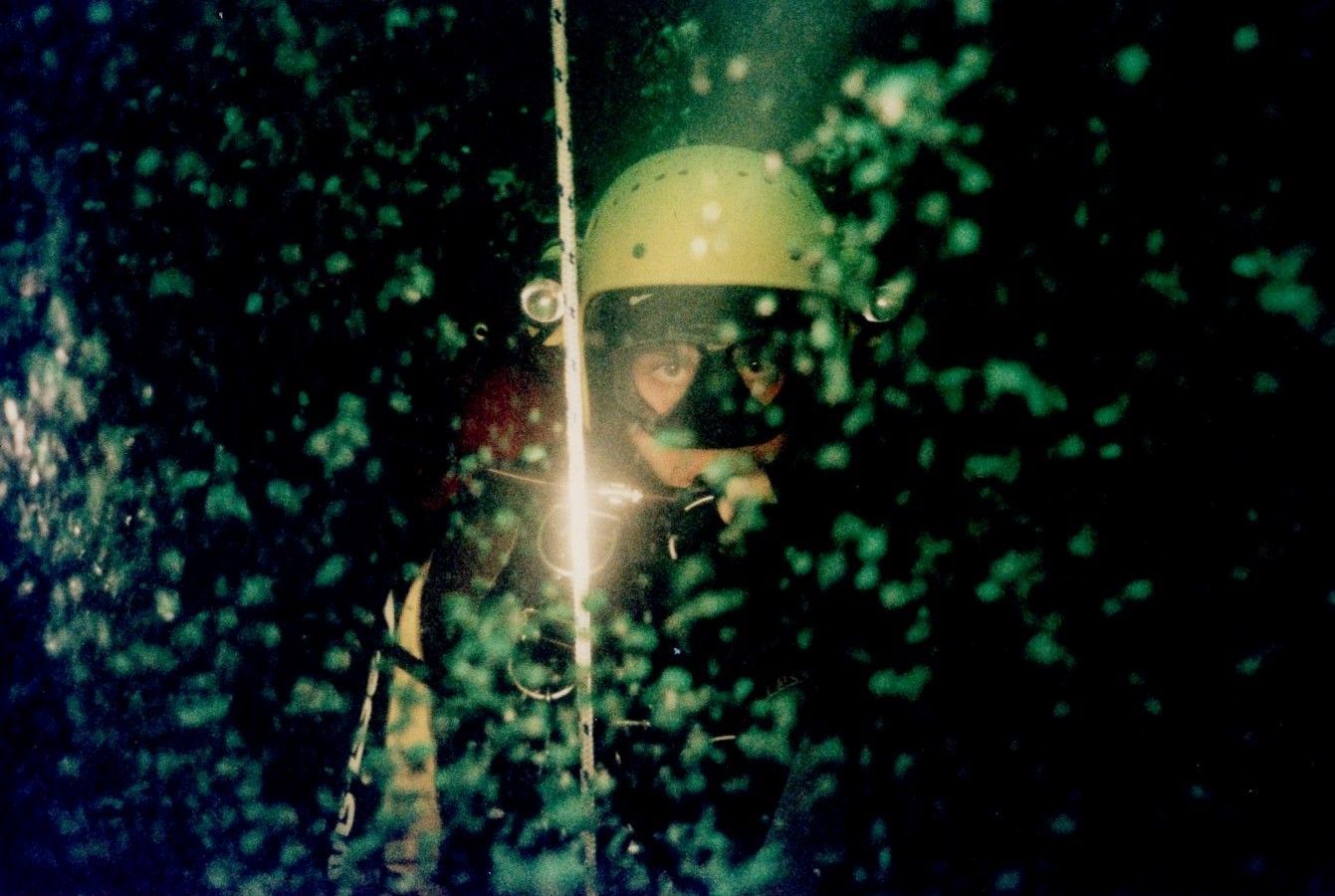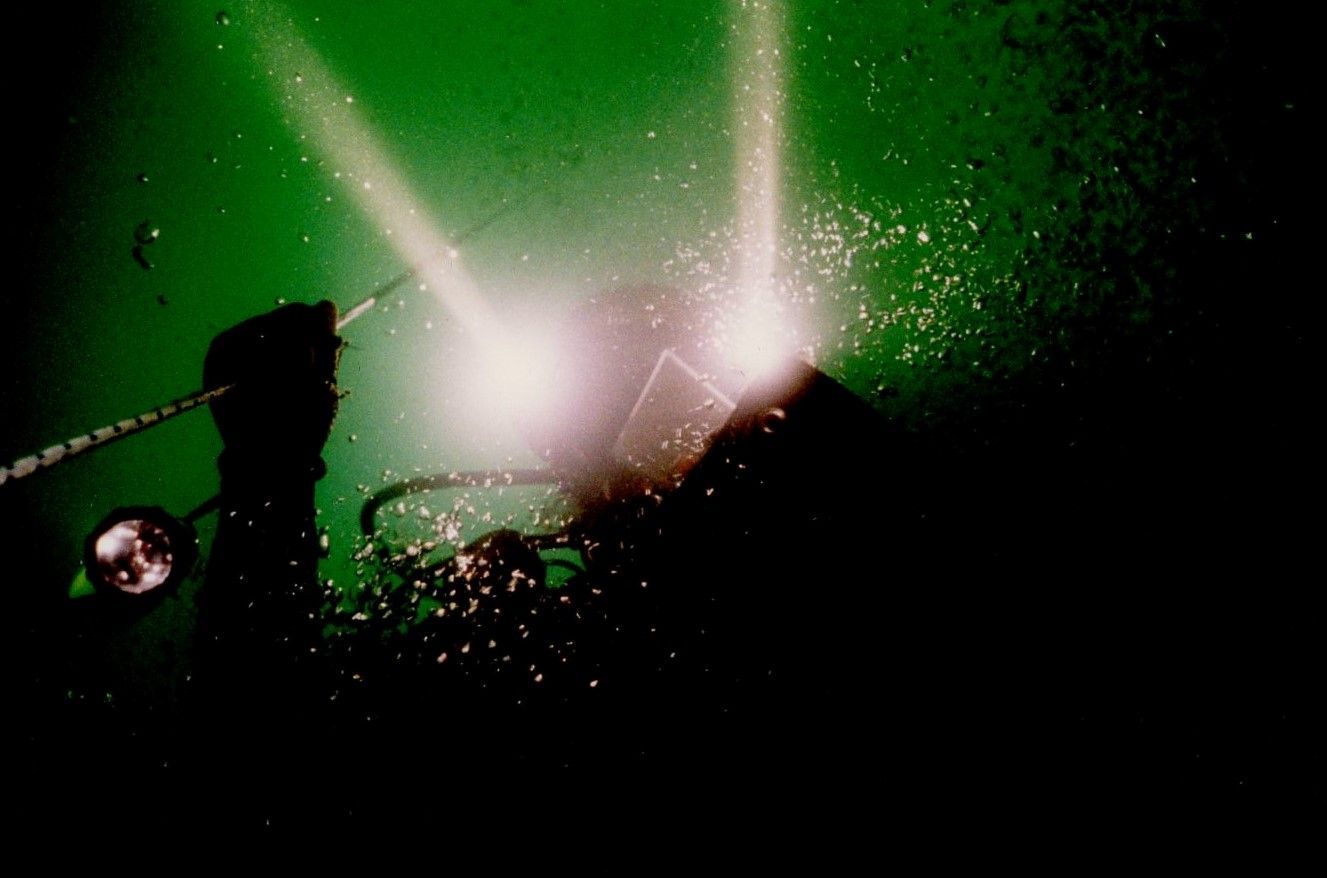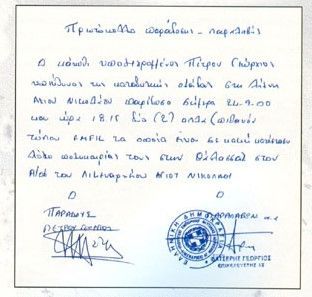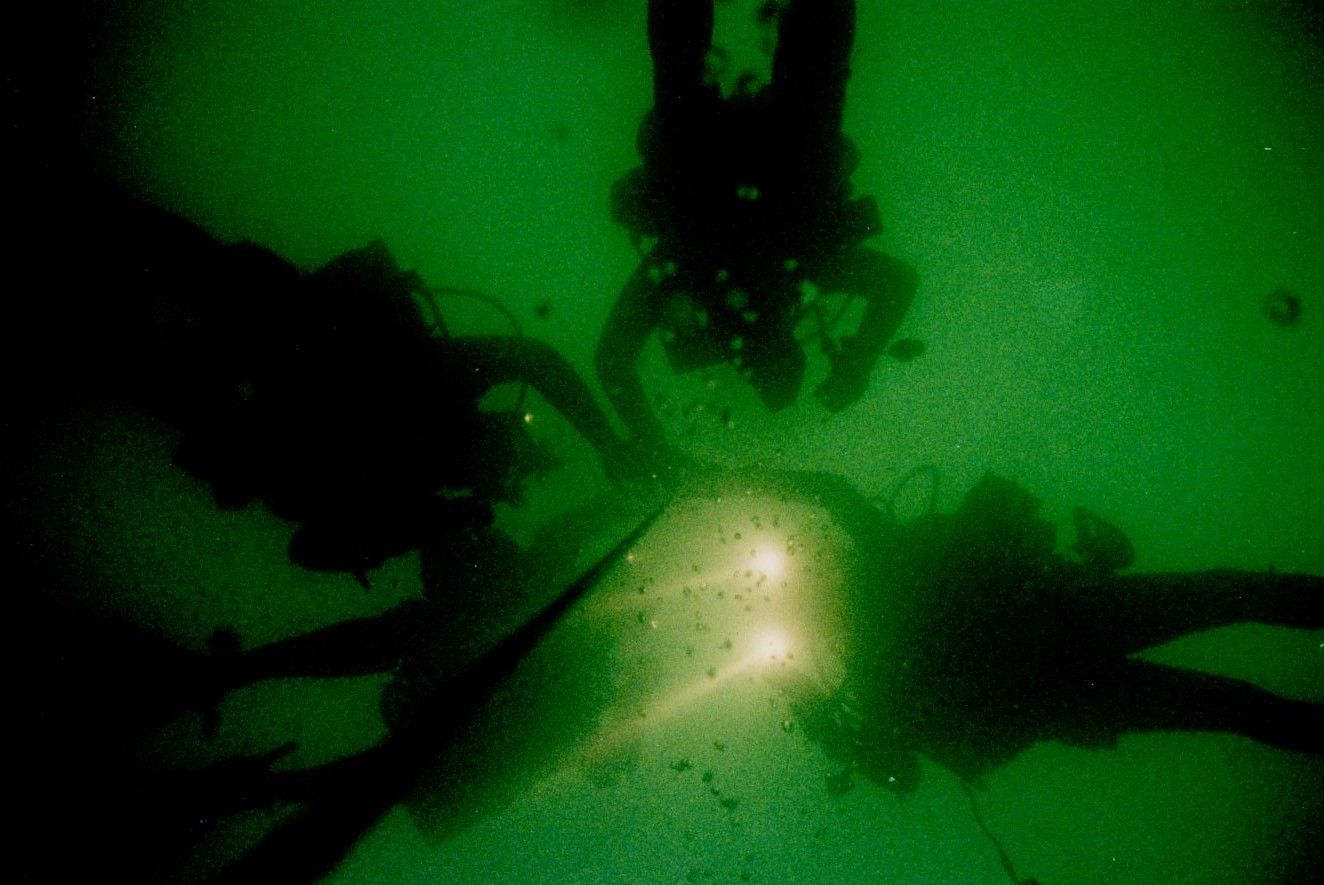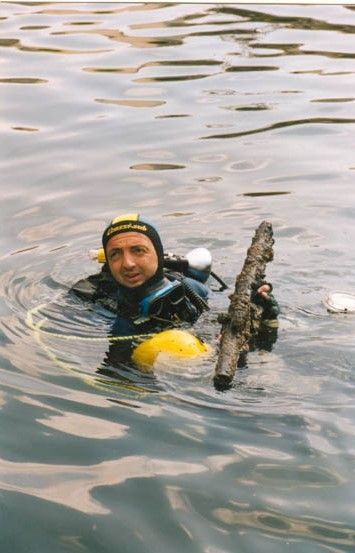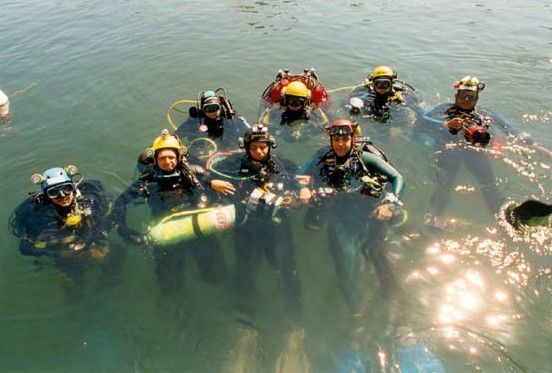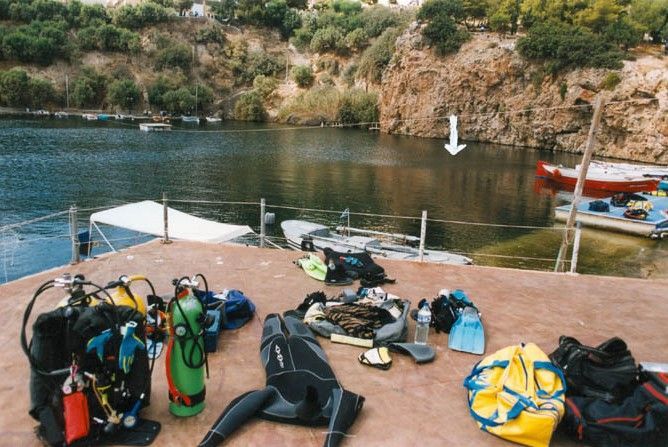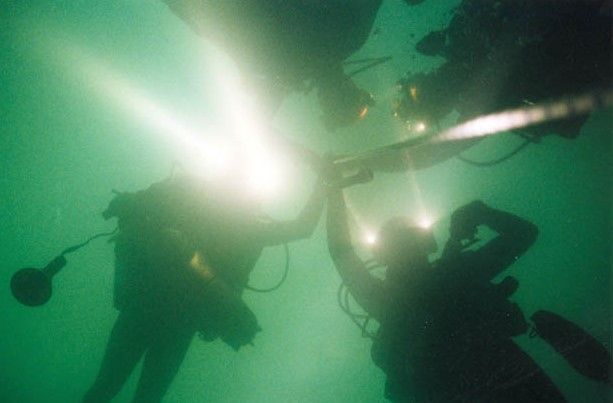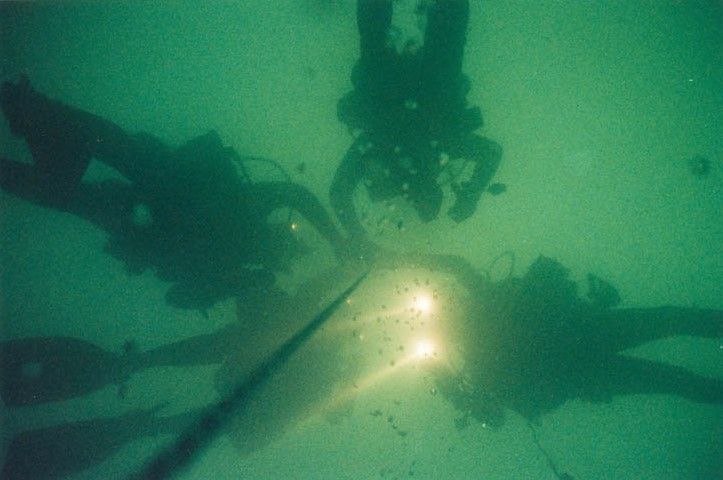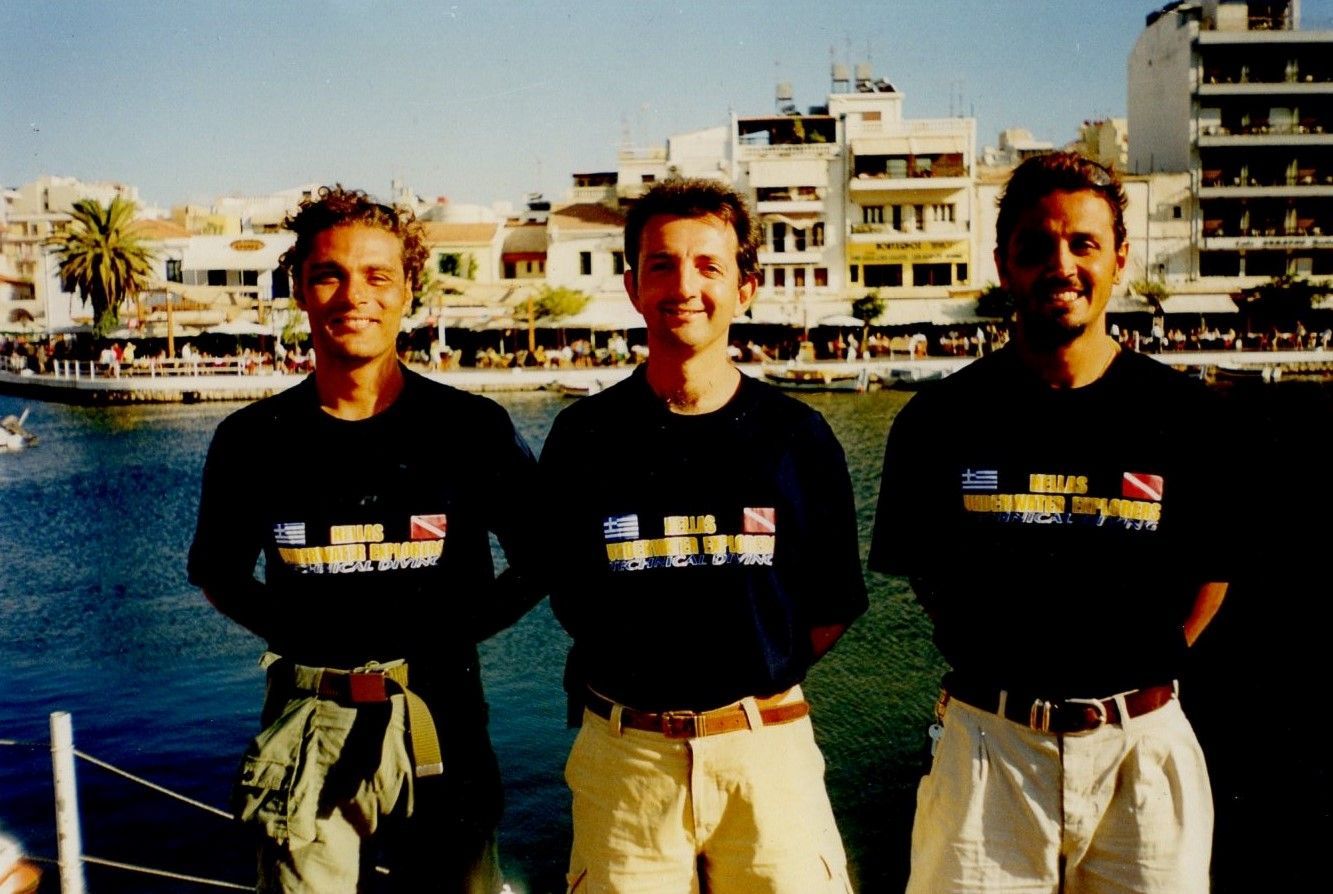Εξερεύνηση Λιμνοθάλασσας Αγίου Νικολάου, Κρήτη
SEPTEMBER 2000
Hellas Underwater Explorers - Exploring the Lagoon of Agios Nikolaos, Crete
Columnist: George Petrou
Photos: G. Vandoros, Chr. Bletsos, G. Petrou and other members of the expedition.
Video: Michalis Tzenevrakis
Lost deep in time, the myths wanted the Abyss of the Lagoon of Agios Nikolaos to be an Abyss, a bottomless lake around which countless stories were woven.
This lake is actually a doline formed by erosion.
In 1945 it is said that the conquerors, while fleeing, threw all their light and heavy weapons into it so that it would not fall into the hands of the Cretans!!! That is what the elders say... and we trust them!
In 1978, the legendary figure of Captain Cousteau comes to explore one of the most ambiguous marine areas of our homeland. His experienced divers dive, but the absolute darkness, the extreme cold, (and probably the absence of spectacular finds) keep them away from the secrets of the Lagoon.
The period 22 - 30 September 2000 will be an important period for the history of the lagoon. A Greek Expedition carries out a completely successful series of dives with the aim of Exploring & Mapping the lake. HELLAS UNDERWATER EXPLORERS is one of the most specialized exploration groups with extensive experience in special forms of diving.
The team of 30 people is manned by Technical Diving Instructors, Cave Divers, Amateur & Technical Diving Scuba Divers, Photographers, Video Cameramen, Doctors, Oceanographers, Geologists, as well as surface support personnel. All of them guided by the organizer and Leader George Petrou.
Η υποστήριξη έγινε από το καταδυτικό κέντρο Buble Divers του Εκπαιδευτή Γιάννη Λίγκου. Σημαντική συνεισφορά στην οργάνωση και πραγματοποίηση της αποστολής από τους έμπειρους εκπαιδευτές Μιχάλη Τζενεβράκη, Στέλιο Κατσανεβάκη, Γιώργο Βανδώρο και Γιάννη Μικέλη που ανέλαβαν σαν αρχηγοί ο καθένας από έναν τομέα.
Special mention for their valuable contribution to the entire organization must go to Markella Giannatou, Stavros Oktapodas and Thanasis Nikolaopoulos. But who else can I mention without forgetting, Christos Bletsas, Kostas Tsiorvas, Manthos Marras, Alexia Grampa, Apostolos Pitsiotis...all of them were wonderful.
Να ευχαριστήσουμε ιδιαίτερα το Τμήμα Ωκεανογραφίας του Πανεπιστημίου Αθηνών και την Κα Αποστολοπούλου Μαρία. Να ευχαριστήσουμε τον Δήμο Αγίου Νικολάου, την FSS του Κο Κεφάλα, την Blue Star Ferries και όλους τους δημοσιογράφους, κανάλια, εφημερίδες και ΜΜΕ που κάλυψαν την όλη αποστολή, την Cressi Sub Αποστολίδης ΑΕΒΕ.
The diving begins with the whole world of Crete watching with great interest. The local authorities supported the project to the fullest extent possible. The interest of the media nationwide is enormous. Lost deep in time, these myths wanted the Abyss of the Lagoon of Agios Nikolaos to be an Abyss, a Lie, a bottomless lake around which countless stories were woven. In 1945, the conquerors, while fleeing, threw all their light and heavy weapons into it so that it would not fall into the hands of the Cretans. Weapons, tanks, radar!!! All the elders confirm the fact but no one believes them.
In 1953 the fish died suddenly, with a great stench emerging, and the waters acquiring a yellow color. It is connected to the Santorini volcano, many whispered. The lagoon is a great mystery that fascinates and provokes on a global level.
The period from 22 to 30 September 2000 will be an important period for the history of the lagoon. A Greek Expedition will carry out a series of dives with the aim of Exploring & Mapping the lake. HELLAS UNDERWATER EXPLORERS is one of the most specialized exploration groups with extensive experience in special forms of diving. The preparation began in 1998 as the expedition leader George Petrou informs us.
. Οι καταδύσεις ξεκινάνε με όλο τον κόσμο της Κρήτης να παρακολουθεί με μεγάλο ενδιαφέρον. Οι τοπικές αρχές υποστήριξαν το εγχείρημα στο μέγιστο δυνατό. Το ενδιαφέρον των ΜΜΕ πανελληνίως είναι τεράστιο.
The diving begins. The research is carried out in very difficult and even extreme conditions. Up to 15 to 20 meters the water has an intense gray-green color and there is a lot of life, flora and fauna. The temperature is 26 degrees Celsius. Below that depth, even the slightest light is lost. The divers are immersed in darkness. For people on the surface, the wait is excruciating. Despite safety measures and excellent preparation, the dangers from unpredictable factors always threaten us.
The divers emerge and while everyone, outside the exploration team, believes that it will be difficult to find anything, a weapon and bullets from those thrown by the conquerors are triumphantly retrieved from a cliff on the sides of the lagoon, confirming what the elders said. If I remember correctly, Michalis Tzenevrakis and Yiannis Mikelis began the dance of discoveries. In the following days, after a series of many strenuous dives, other weapons reach the surface. And not only weapons. A German military motorcycle, bayonets and other bullets raise the interest.
From there on, as the days progress, the focus is on finally finding the bottom of the lake. A system of ropes with bars has been set up, from which the team will dive and in which they will then do the required decompression. Large lights will try to illuminate the path of the explorers, but once they fall into the terrible sediment, all they succeed in is forming a white curtain that limits visibility to 30 points!!! Powerful moments of eternity and suddenly at 51 meters we finally illuminate the first muddy and silent bottom of the lake.
Spreading our legs, we explore about 50 meters away from the bar, while one of the leaders of Apostoli, Michalis Tzenevrakis, records this new world for all of us with his video camera.
Our planned stay time has expired, and we return to the decompression bar for the ascent to the surface light. A long decompression time at depths of 12 to 3 meters that we are required to do before we emerge prolongs the anxiety of those waiting for us on the surface.
We all emerge, and our smiles, in addition to the very exciting dive that we did in complete safety, let them know that we had finally found the bottom. There is a bottom and it is initially located at a depth of 51 meters at the specific point where we dived. The team completed its work when its scientific members from the University of Athens carried out a series of investigations that brought to light important results.
The exploration team said goodbye to the always hospitable Crete and the warm residents of Agios Nikolaos who supported us so much, and already on the return trip we began planning our next exploration mission.
Scientific Work
George Katsanevakis Oceanologist
I. Depth survey A depth survey of the lagoon was carried out using a depth sounder from a fishing boat. The entire surface of the lake was scanned and the greatest depth recorded was 50m. The lake exhibits a strong bathymetric gradient and presents a deep oval-shaped plateau with an axis parallel to the major axis of the lake, with depths ranging from 41 to 50m.
II.Measurement of temperatures
Temperature measurements were taken at 7 different points in the lagoon throughout the water column. The measurements were made with a Hydro-Bios electrode from the surface to the bottom and every one meter. The diagram below shows all the measurements.
We observe the following:
Το βαθύτερο σημείο μέτρησης ήταν στα 46 μέτρα, όπου επικρατούσε θερμοκρασία 16,4 oC, ενώ οι μεγαλύτερες θερμοκρασίες μετρήθηκαν στην επιφάνεια και έφταναν τους 26,8 oC. Η θερμοκρασία εμφανίζει μικρή μείωση από την επιφάνεια έως τα 10m (από τους 26,6 oC στους 24,5 oC), ενώ από τα 10m έως τα 19m υπάρχει ένα έντονο θερμοκλινές και η θερμοκρασία πέφτει στους 18 oC. Από τα 19m και κάτω η θερμοκρασία συνεχίζει να μειώνεται αλλά με μικρότερους ρυθμούς φτάνοντας στην ελάχιστη τιμή της στα 46m.
At one measuring station (ANS07) the temperature showed a very small increase after 30m which may be due to a slight downdraft. There is no differentiation between the measuring stations, with the sole exception of station ANS07 below 30 m. There is an obvious stratification of the water masses, which is caused at this time of year (warm months) by the limited recycling of the lake waters due to the narrow and shallow channel that connects it to the sea, the intense heating by the sun of the surface waters and the lack of intense waves due to the small surface area of the lake. In other words, there are the surface warm masses that are slightly renewed through the channel and the deep cold masses that are not renewed and therefore not oxygenated sufficiently as is also evident from the measurements of dissolved oxygen.
III. Dissolved oxygen measurement Water samples were taken from various depths (from 0 to 30m) and analyzed for dissolved oxygen concentration. The measurement of dissolved oxygen was done with a YSI electrode.
The results are shown in the diagram below.
We observe the following: In the first few meters, due to contact with the atmosphere and the renewal of water from the sea through the channel, we have supersaturation in dissolved oxygen. Gradually, the concentration of dissolved oxygen decreases with depth. Below 12m, the waters become hypoxic, as the concentration of dissolved oxygen drops below 2mg/lit, while from 16m it drops even below 1mg/lit. The result of the hypoxic conditions is that aquatic life is dramatically limited below 12m and very few organisms survive. This observation was also made by divers who did not encounter any obvious sign of life below 12m. On the contrary, in the first few meters from the surface, the lake has life (many large fish, crustaceans, echinoderms, ascidians, mollusks, sponges, algae, etc.).
In the sediment of the lake bottom at great depths, the conditions are anoxic. Due to the action of anaerobic bacteria, we have the production of H2S, CH4, etc., resulting in a strong stench and toxicity for most aquatic organisms. The stench was strong and noticeable even to scuba divers who descended to these depths. It should be noted that this situation prevails at the specific time when the research was carried out. In the winter months, the situation will most likely be completely different, as the thermocline will "break" and the richly oxygenated surface waters will descend to great depths, oxygenating the lake bottom. In order to determine the situation during the winter months, the measurements will have to be repeated. It should also be noted that the state of anoxia is most likely a normal process and is not linked to the pollution of the lake, although any form of pollution from organic materials certainly enhances the phenomenon.
IV. Δειγματοληψίες σκληρού και μαλακού υποστρώματος Οι δειγματοληψίες μαλακού υποστρώματος με αρπάγη (grab) δεν ήταν επιτυχείς λόγω της μεγάλης κλίσης του πυθμένα και της ύπαρξης πολλών στερεών υλικών (πέτρες, σκουπίδια, σχοινιά, κλαδιά κ.λπ.). Οι δειγματοληψίες σκληρού υποστρώματος έγιναν με επιτυχία και τα δείγματα θα μελετηθούν περαιτέρω στο εργαστήριο του τομέα Ζωολογίας - Θαλάσσιας Βιολογίας του Πανεπιστημίου Αθηνών. Τοποθετήθηκε μεταλλικό πλαίσιο στην επιφάνεια του υποστρώματος, με κατάλληλο δίχτυ στη μια άκρη του, και ξύστηκε όλη η επιφάνεια που όριζε. Ότι υλικό ξύστηκε συλλέχθηκε στο δίχτυ και στη συνέχεια τοποθετήθηκε σε πλαστικά δοχεία και συντηρήθηκε με φορμόλη. Να σημειωθεί ότι κάτω από τα 10m οι βράχοι ήταν εντελώς γυμνοί και δεν υπήρχε υλικό για δειγματοληψία. Έτσι, οι δειγματοληψίες περιορίστηκαν στα 10m, στα 5m και στην επιφάνεια.
The Genesis of the Lake - Alexia Grampa Geologist
Crete presents a significant number of characteristic surface and underground Karst formations. The term karst describes areas that are structured by soluble carbonate rocks, such as limestone, with a characteristic relief, which is the result of the mechanical and chemical action of water. The dissolution of rocks by water causes the expansion of cavities within the rock, an increase in its permeability and the possibility of transferring large quantities of water through it. The presence of karst in Crete is due to the large surface spread of limestones, the intense tectonics of the island and the intense paleoclimatic changes that took place during the Early Cenozoic (the last 2 million years). The Karst formations also include the lake of Agios Nikolaos.
It is a doline of sediment origin (Dermitzakis and Mariolakos, 1974). Dolines are closed depressions with a circular or elliptical shape, 10-1000m in diameter and 5-200m deep. Dolines of sediment origin are formed by the collapse of the roof of an underground cavity or cave. If the cavity is filled with water or a subsequent rise in the water level followed (the case of Agios Nikolaos), dolines of sediment origin form lakes of great depth, the bottom of which may be covered by sediment of a fairly large thickness. The collapse of the roof of the cave of Agios Nikolaos is placed in the Upper. Quaternary (approximately 70,000 years ago) (Dermitzakis and Mariolakos, 1974).




